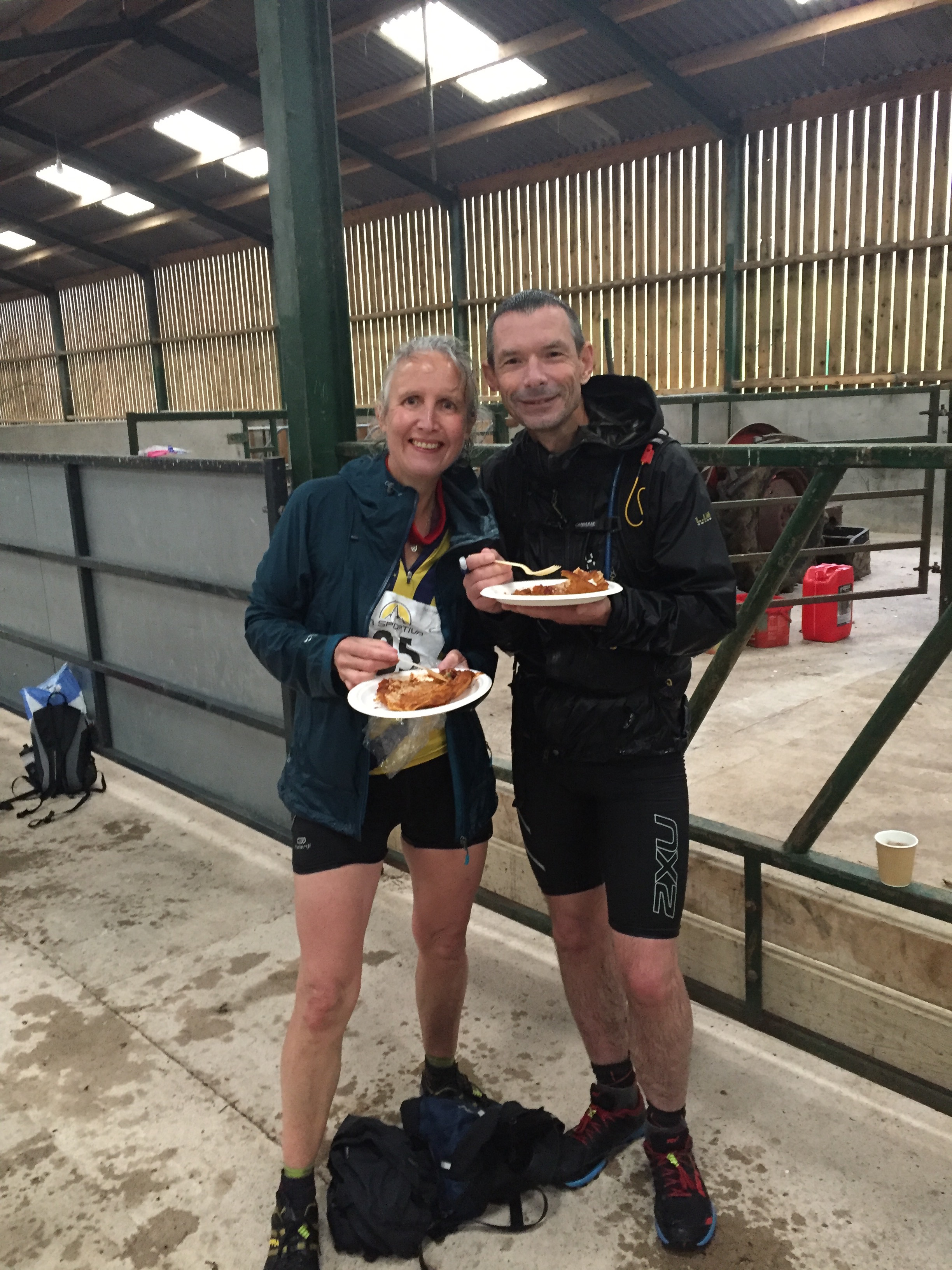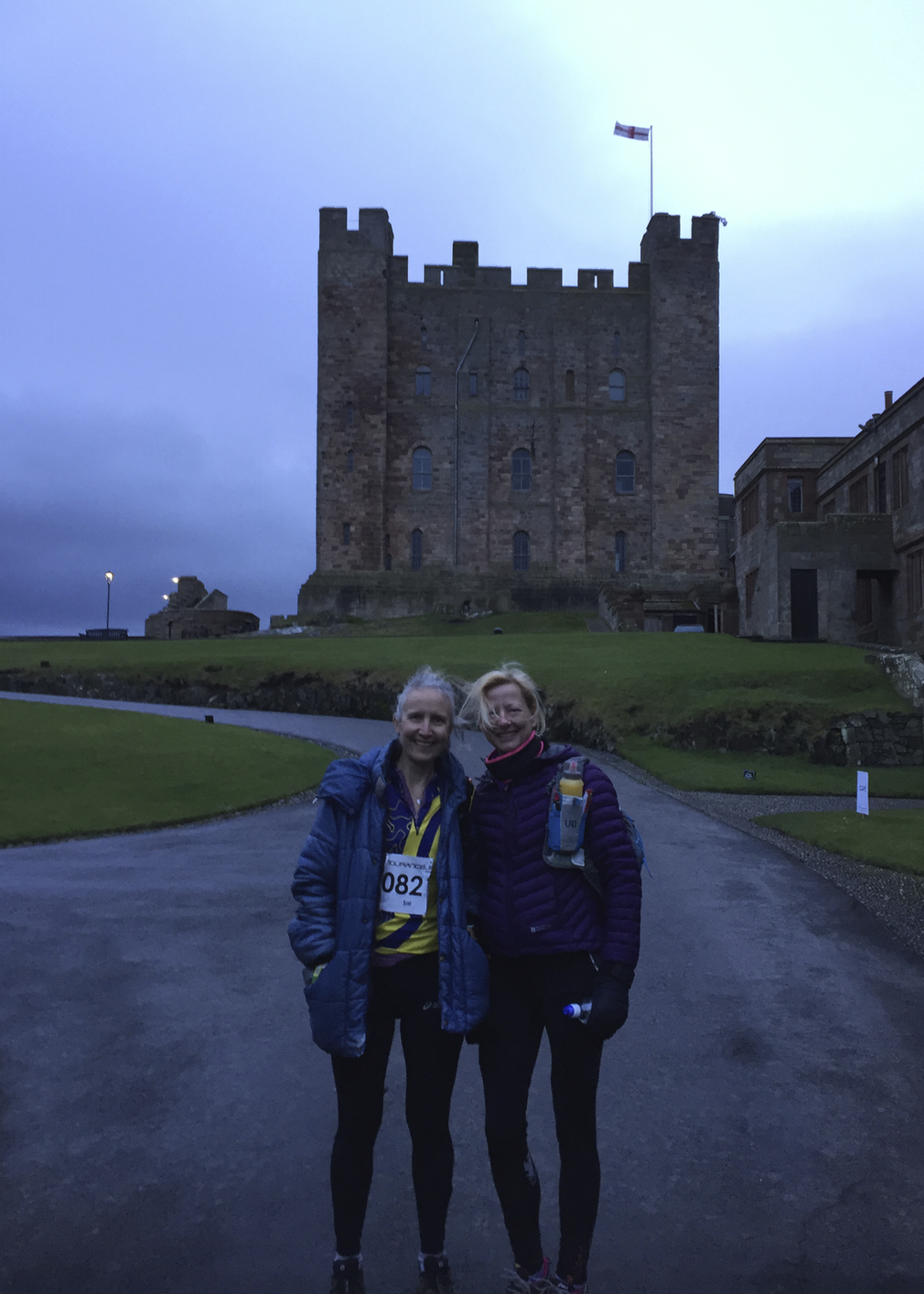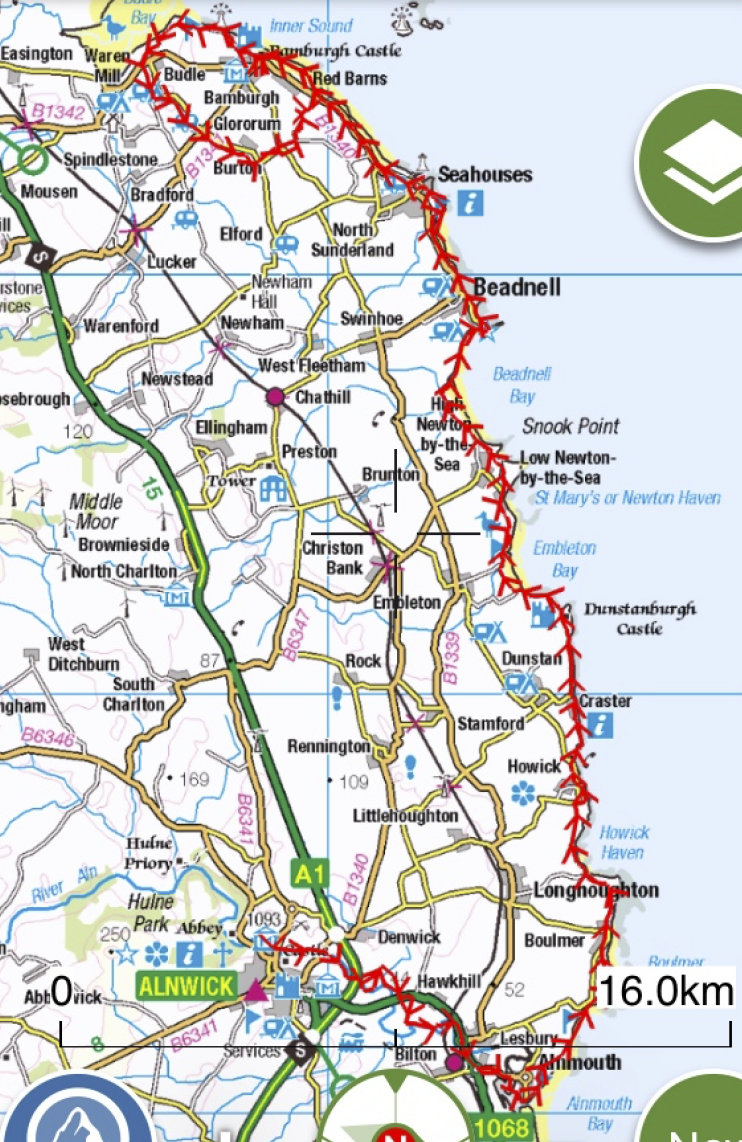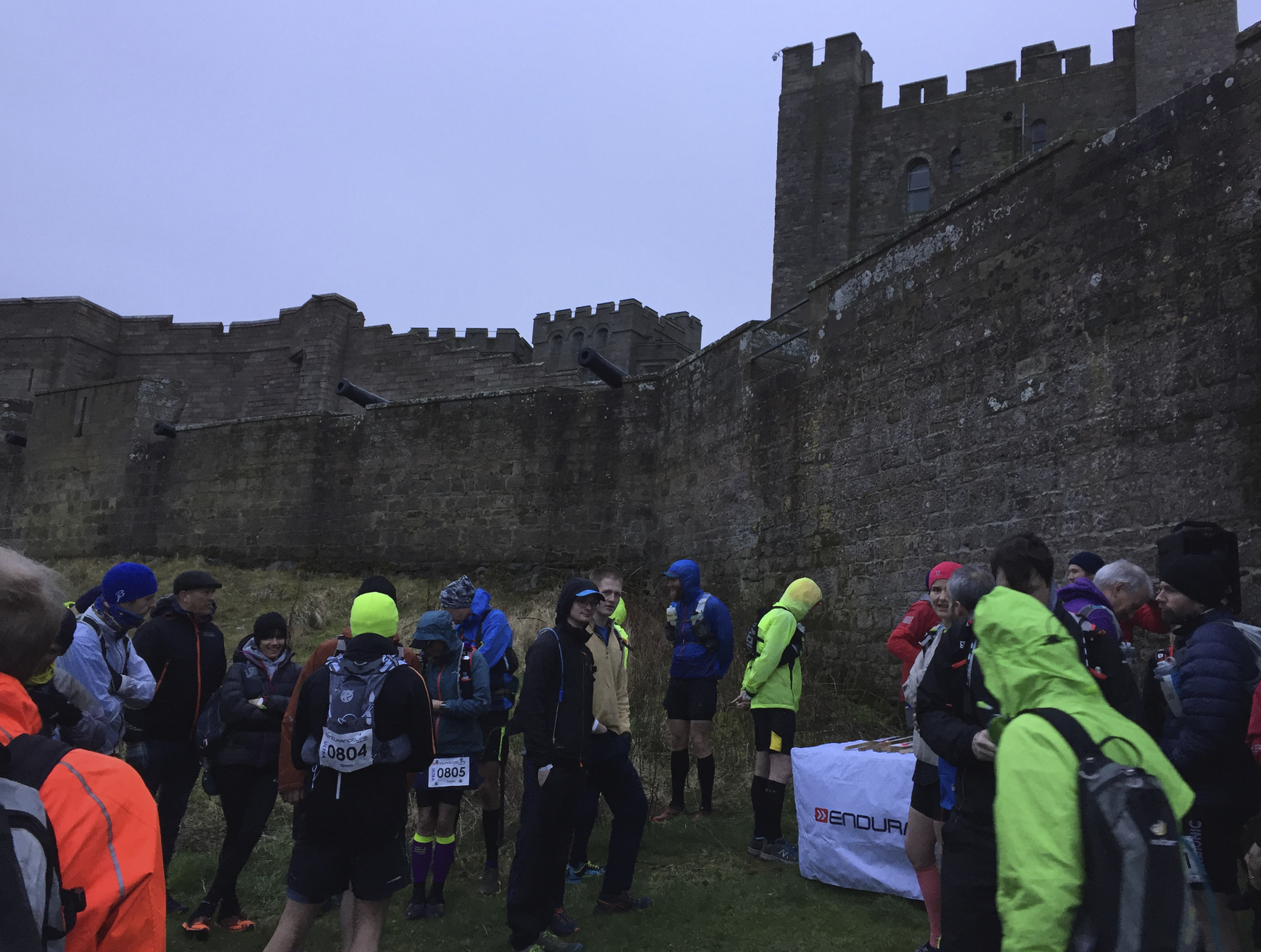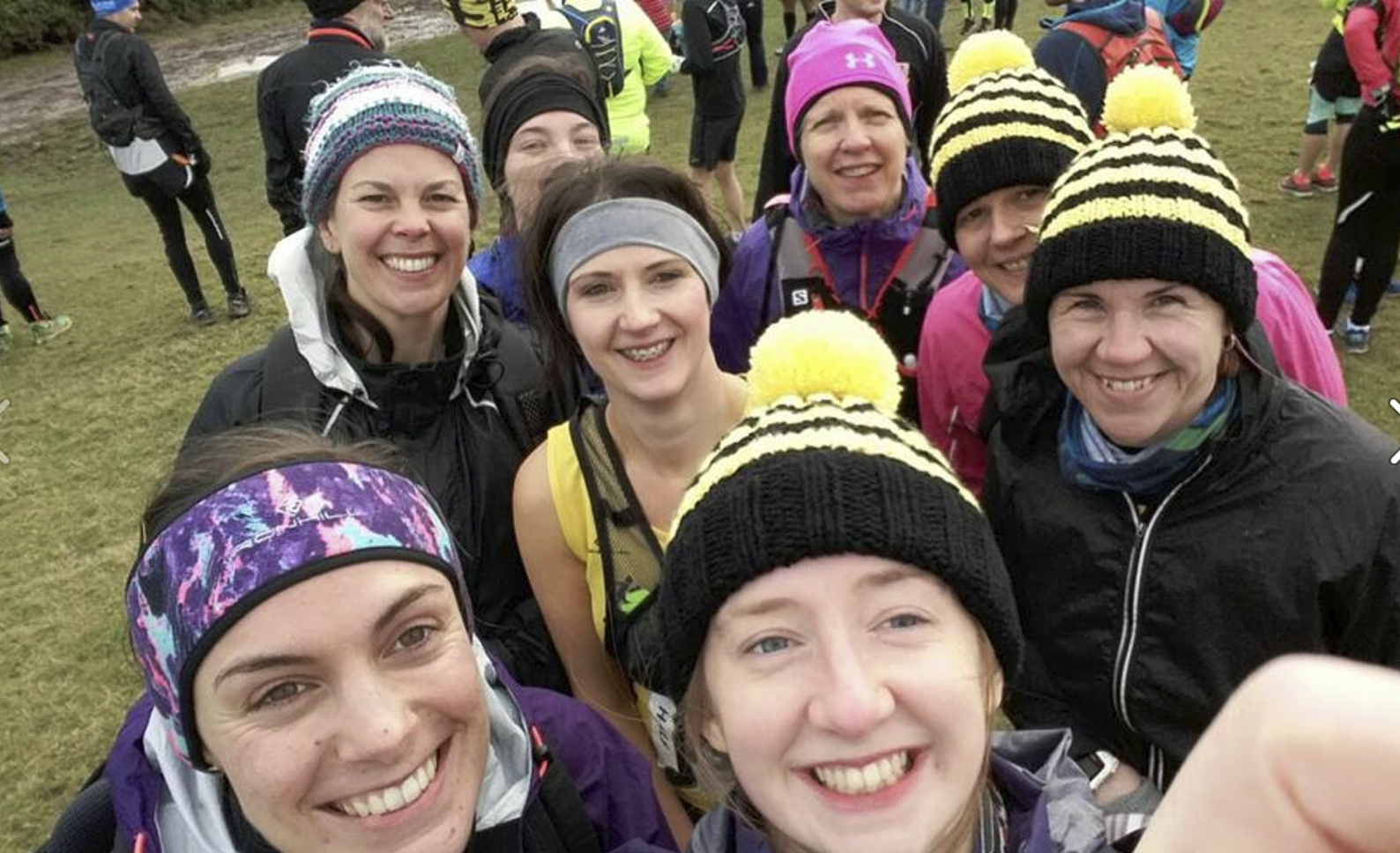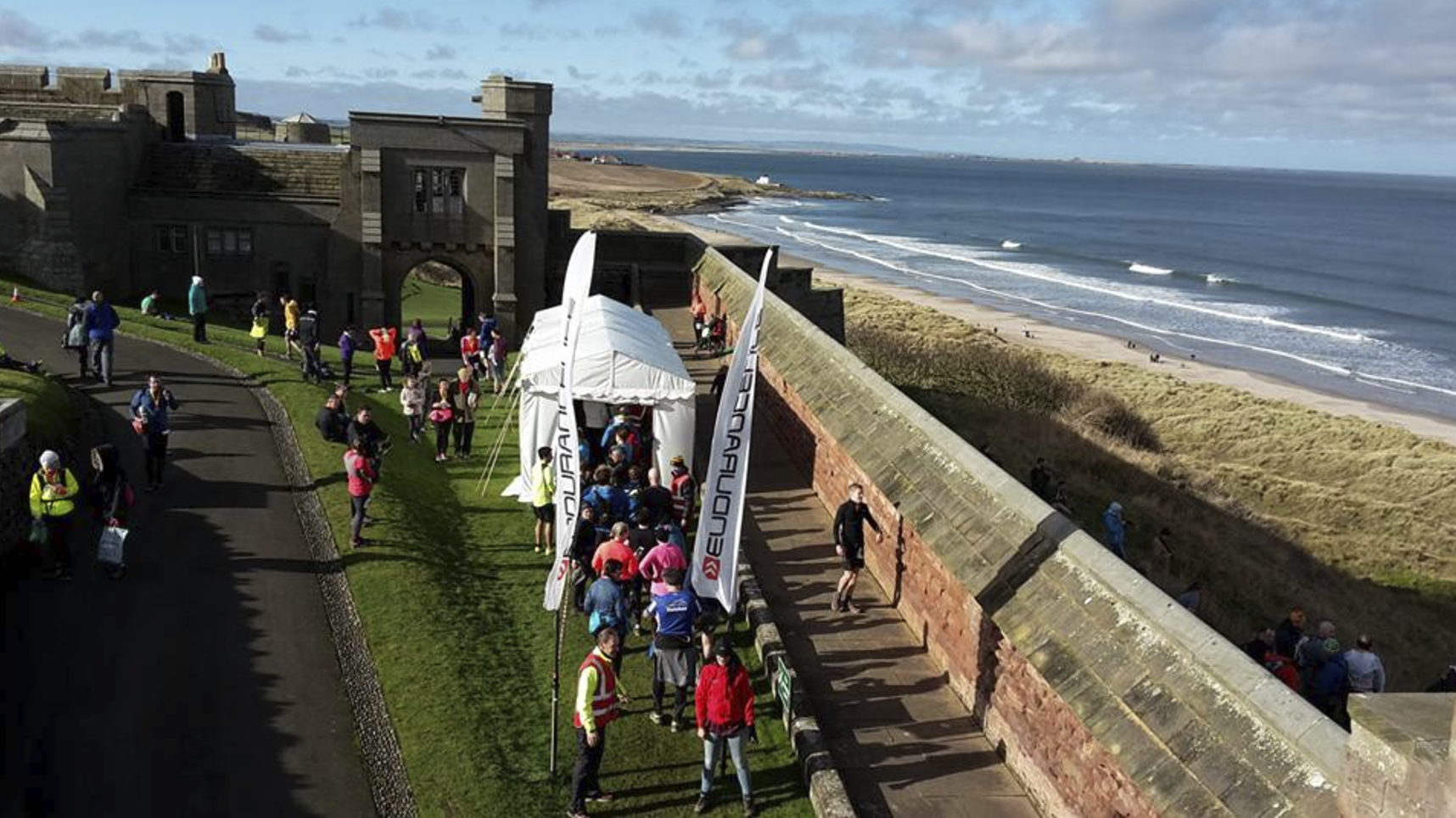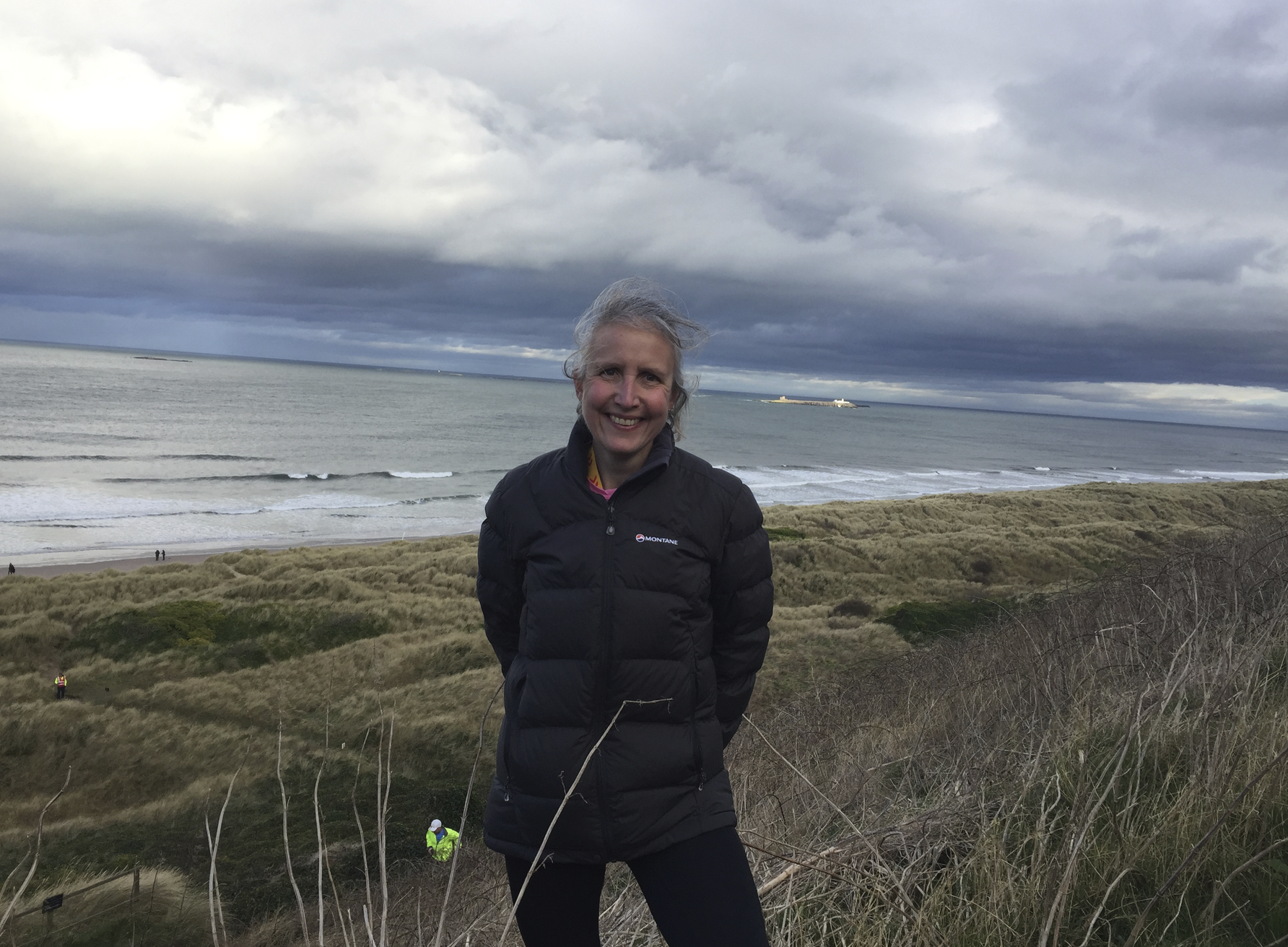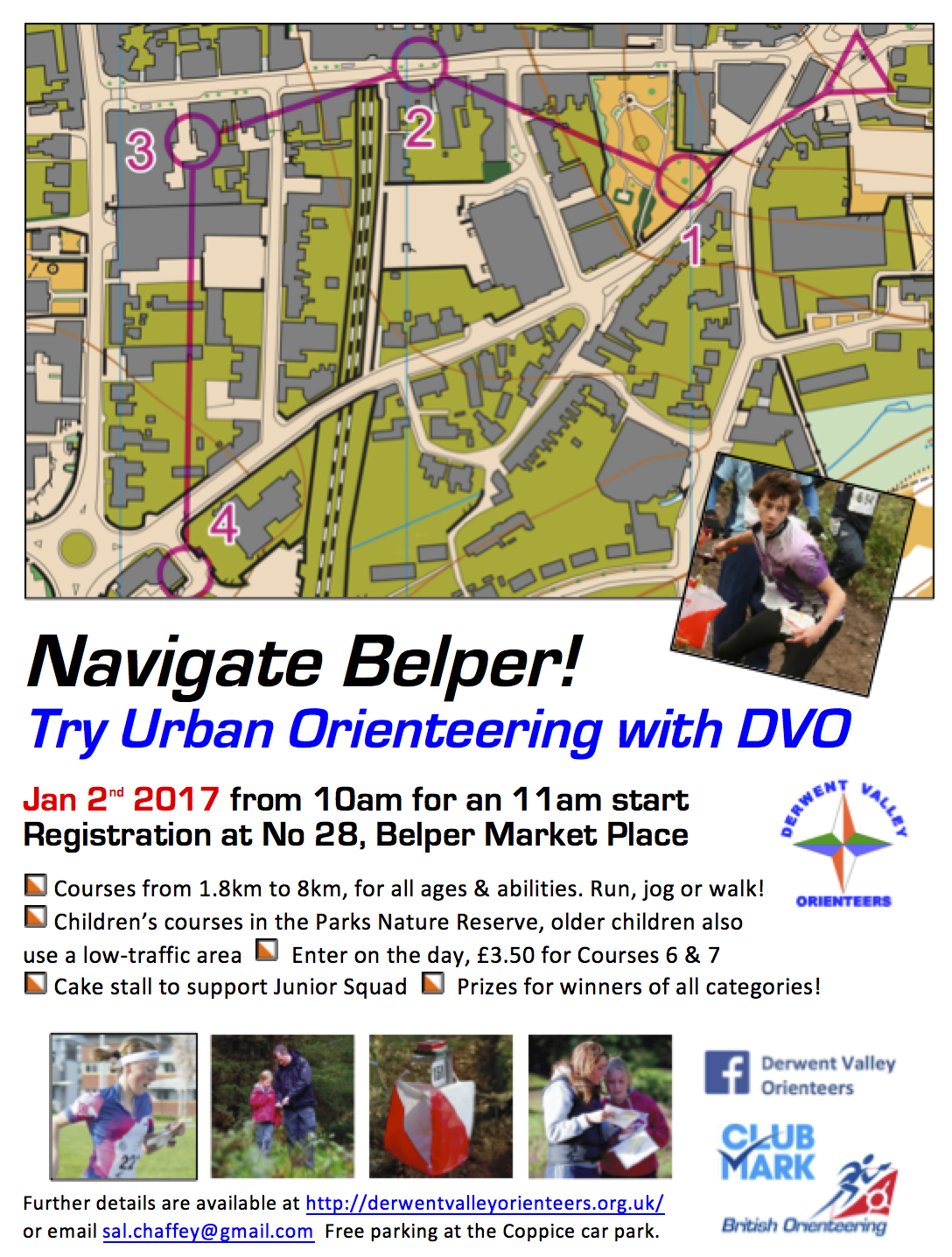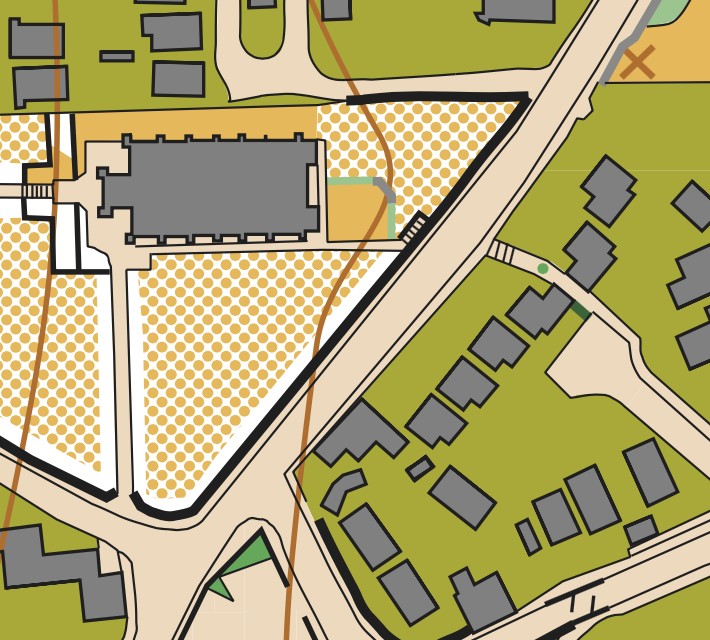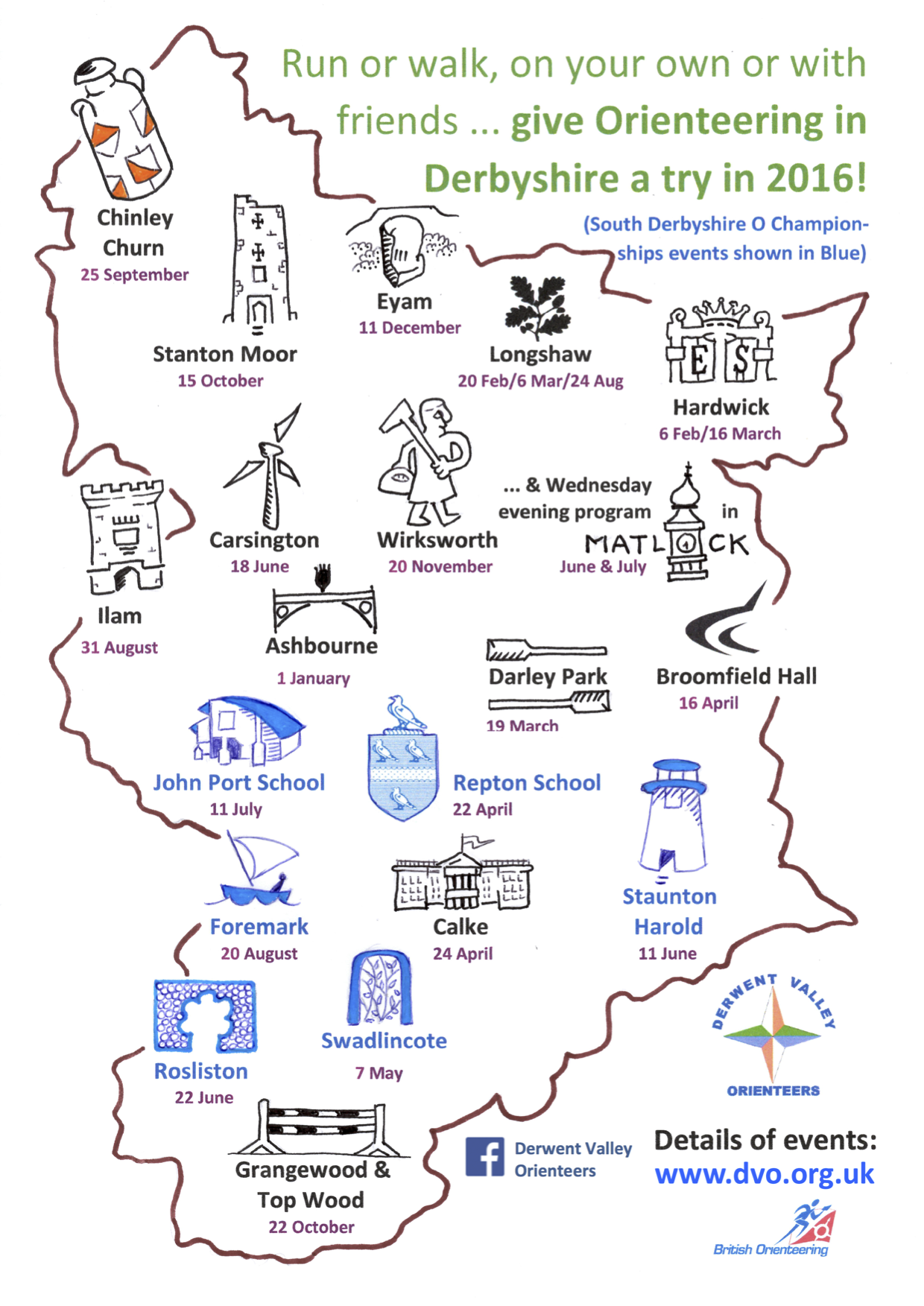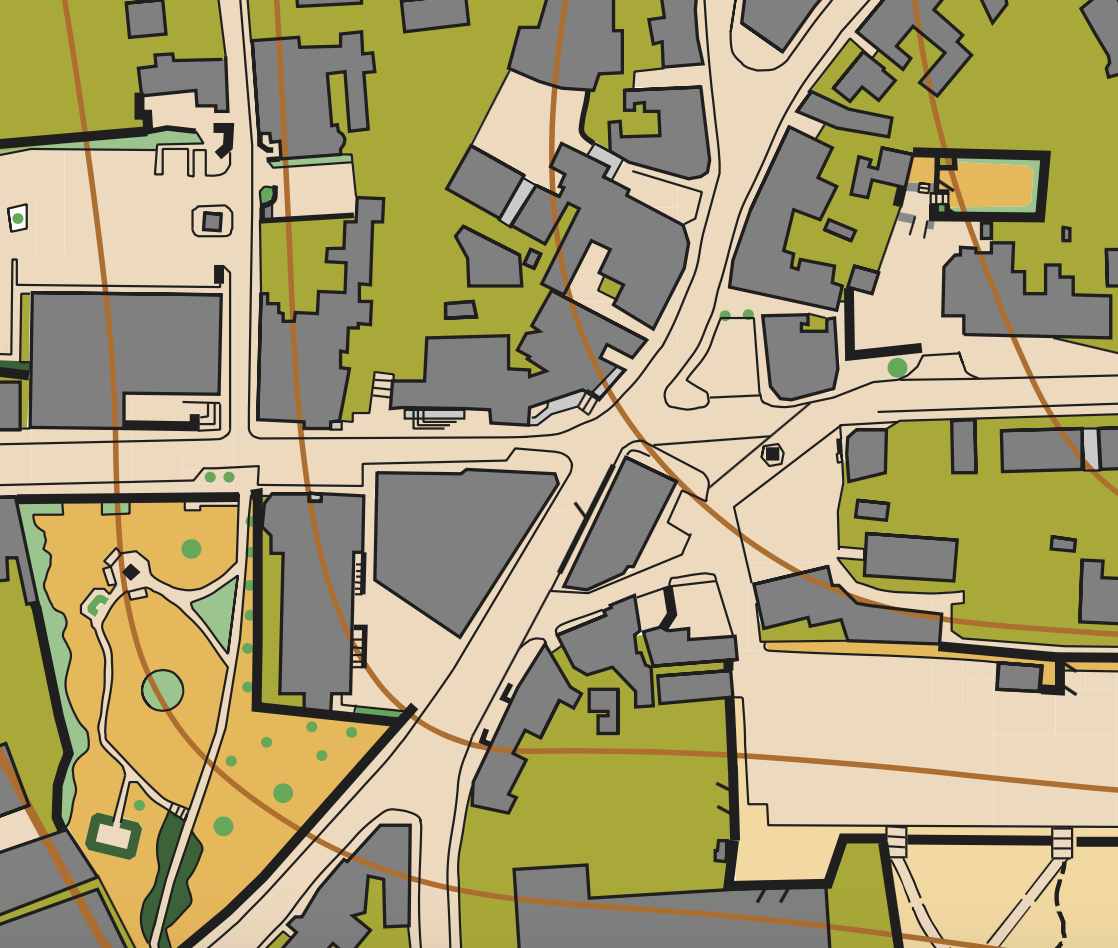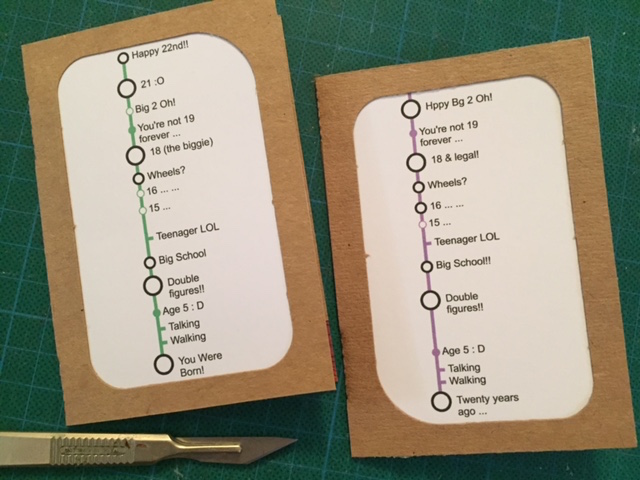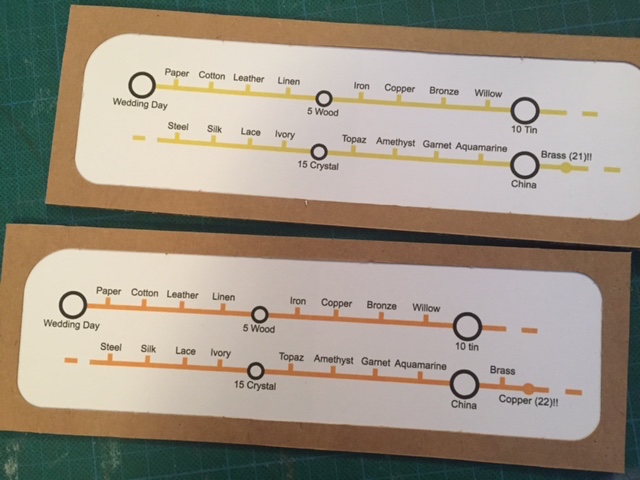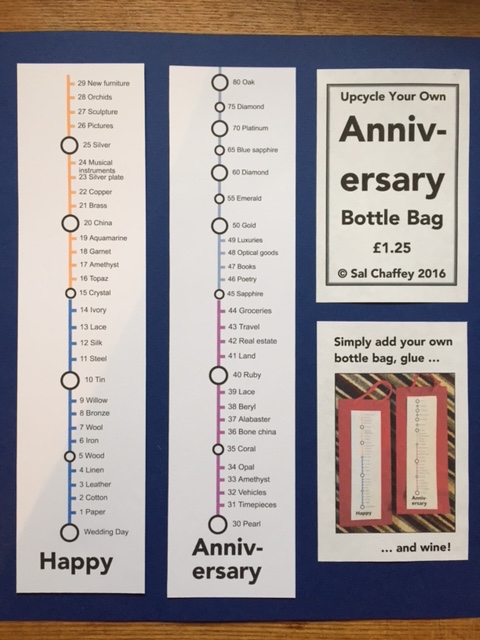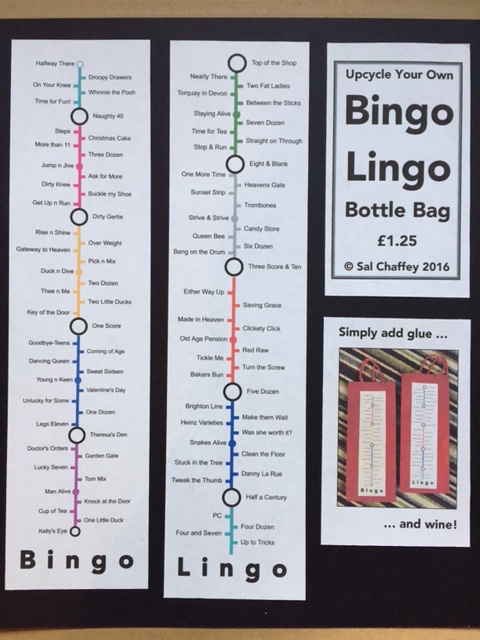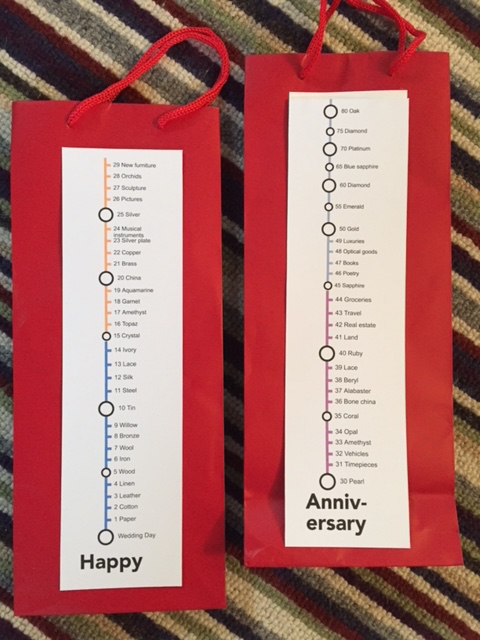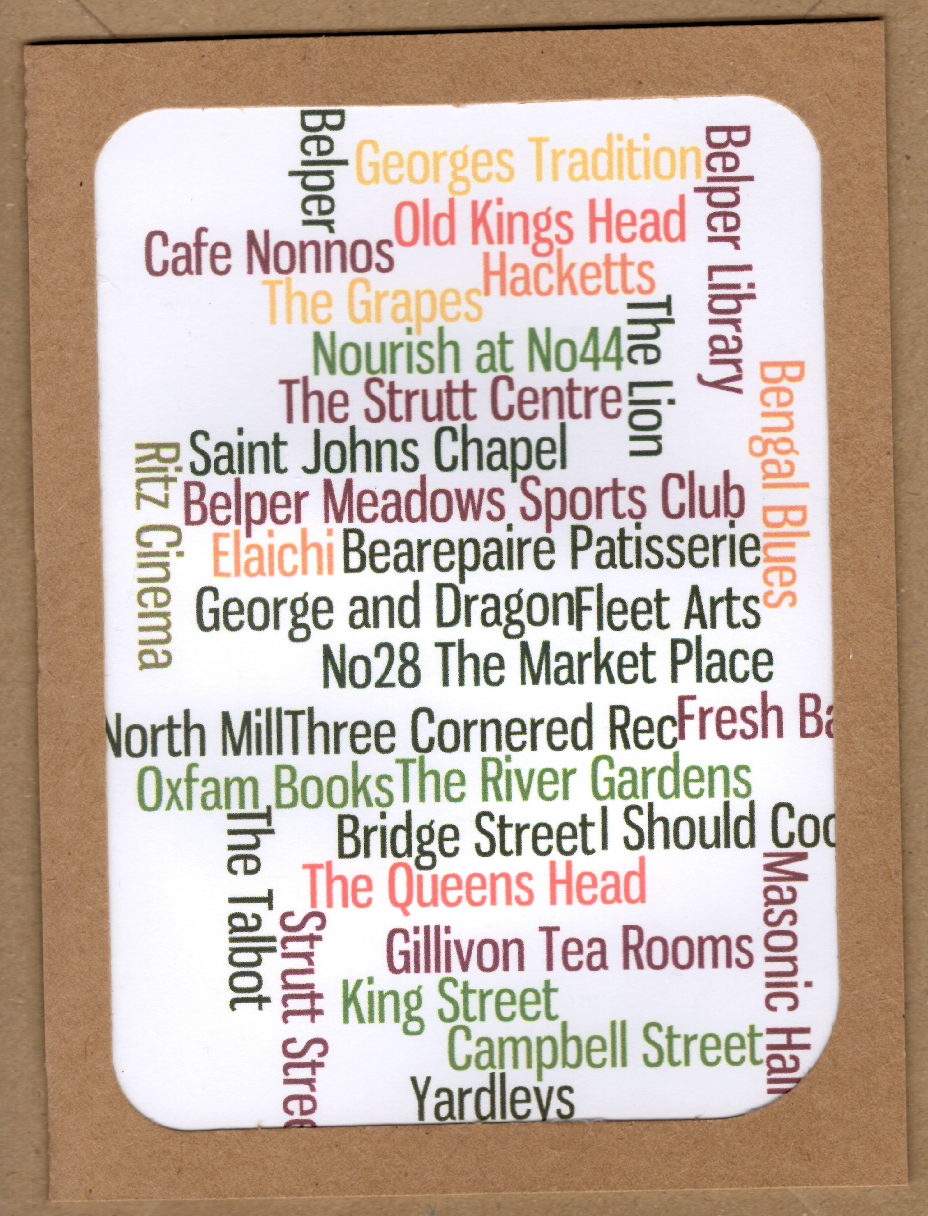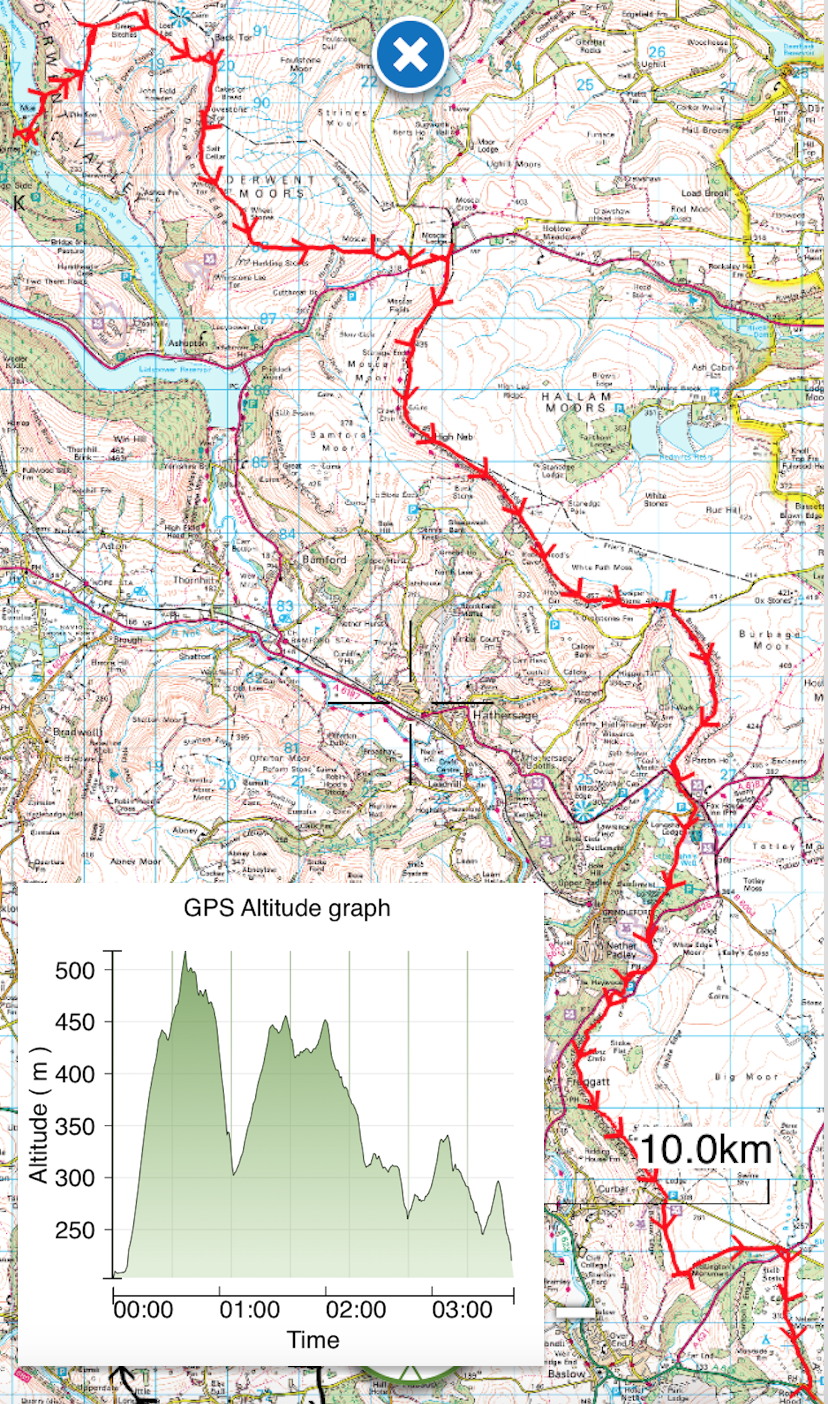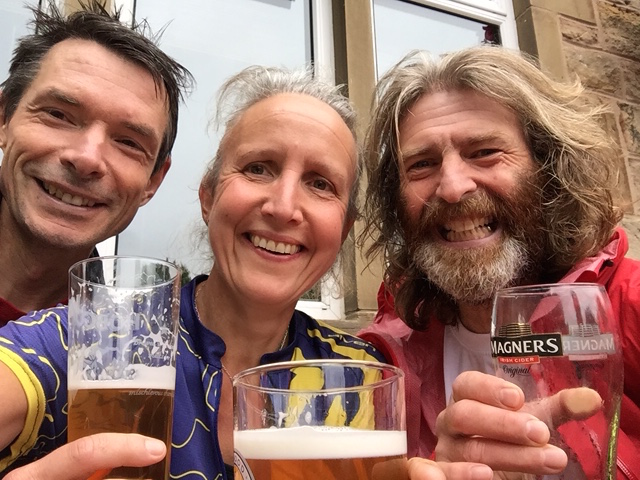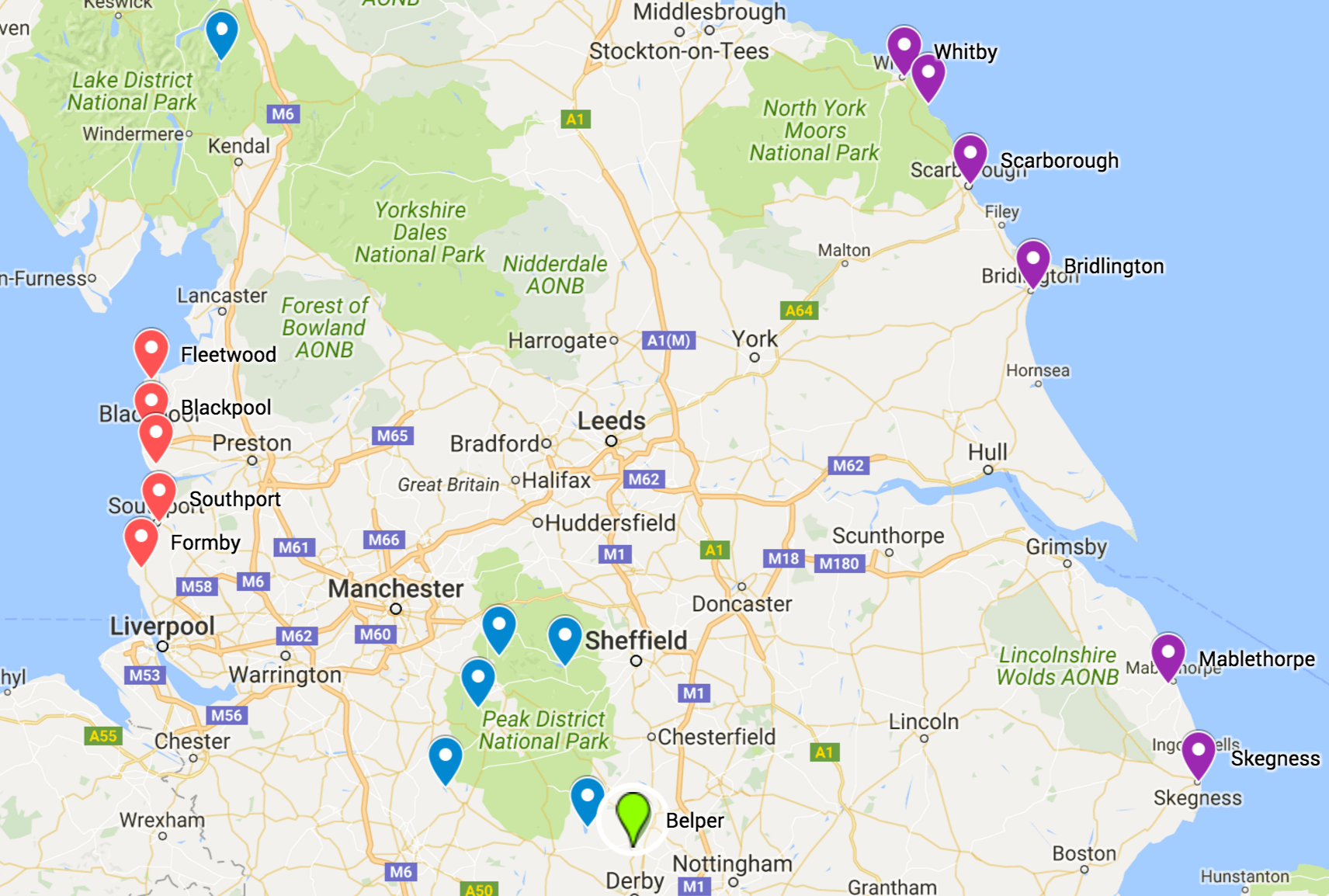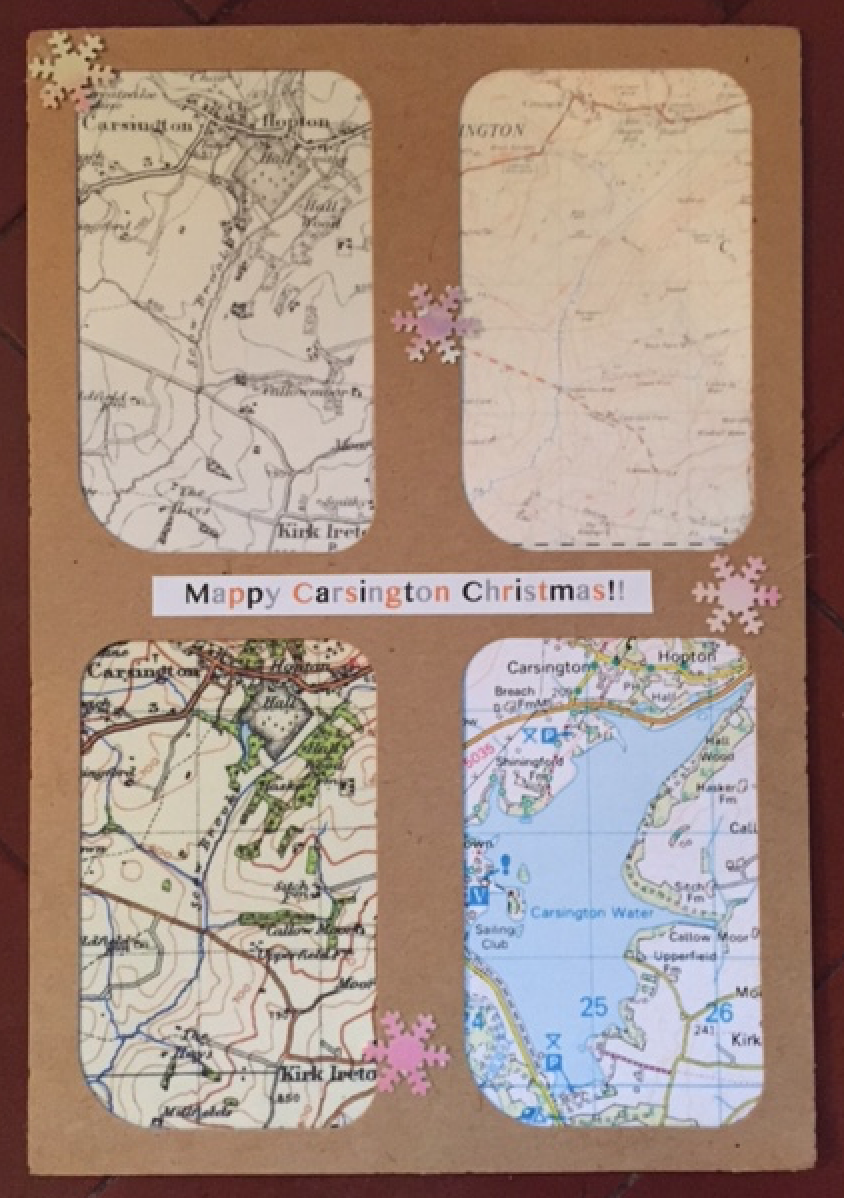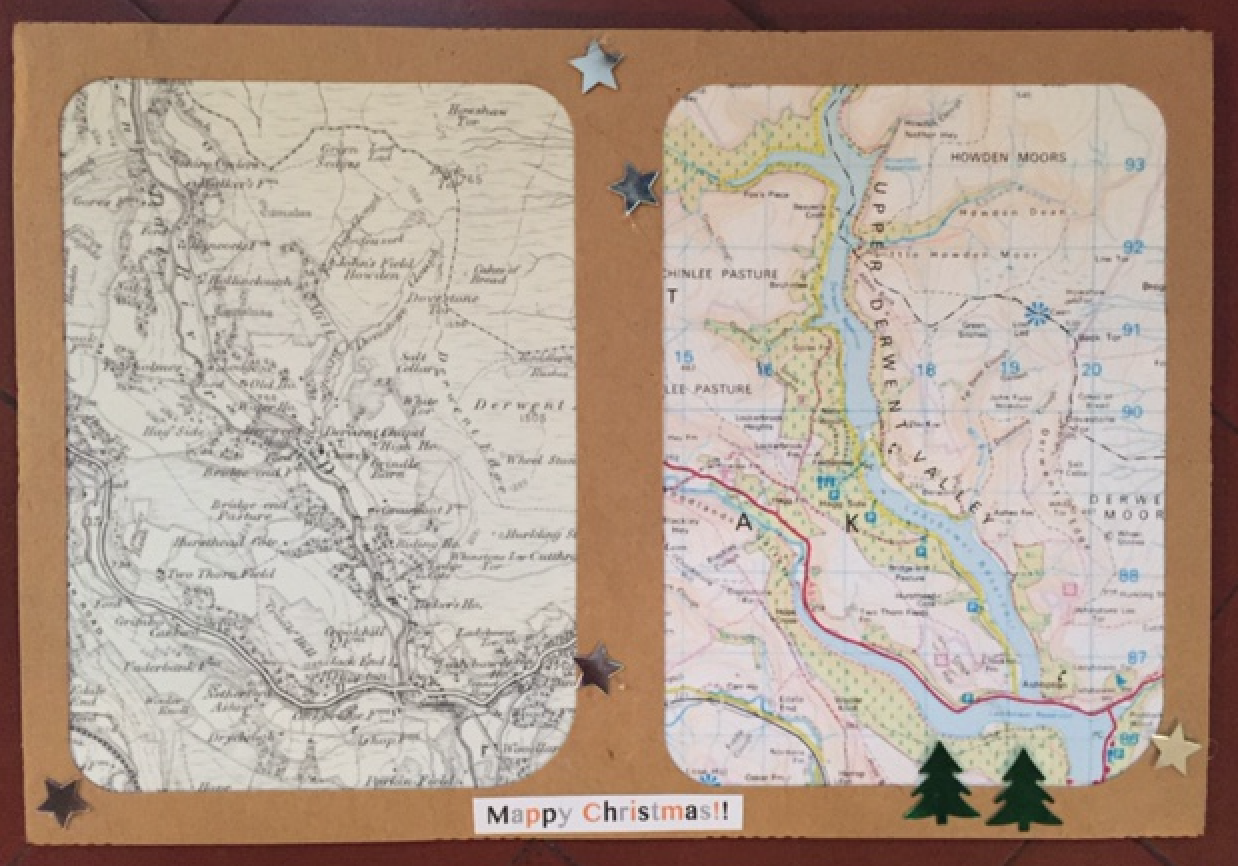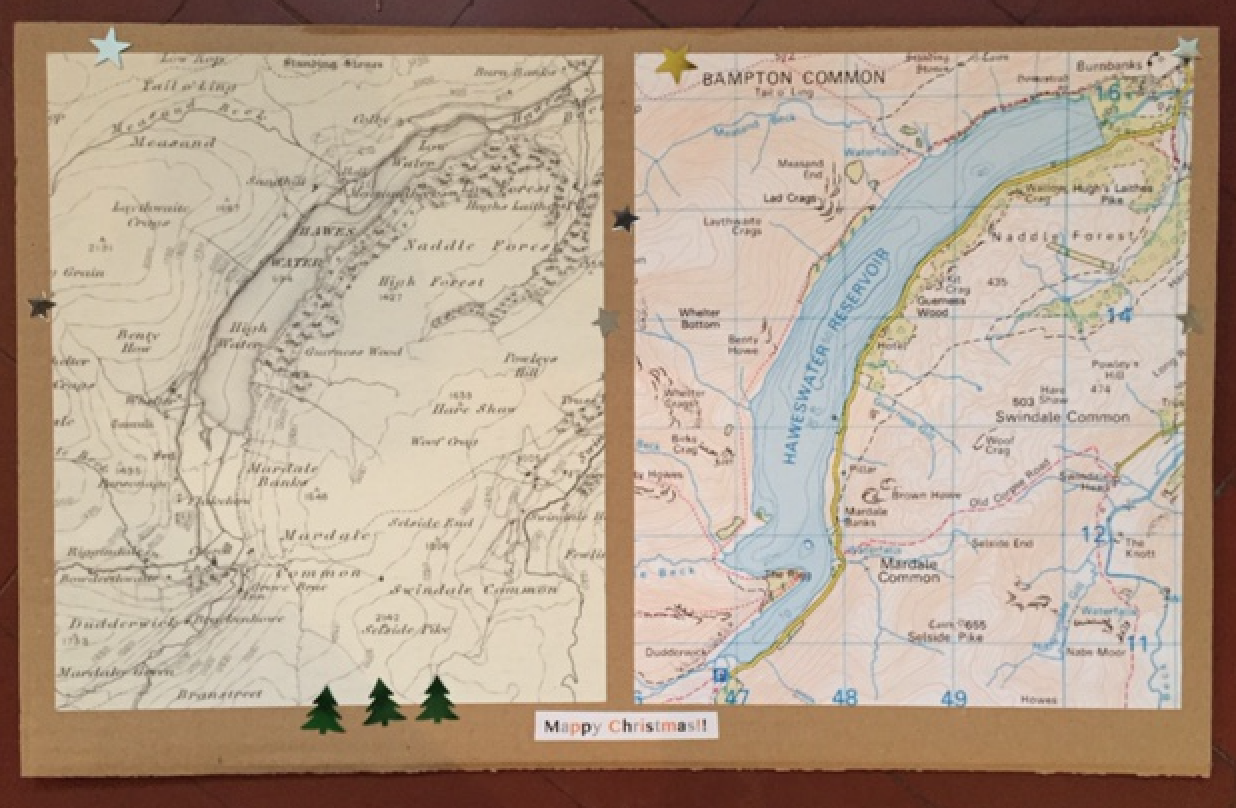Having volunteered with Derbyshire Refugee Solidarity for a few months, sorting donations, helping with English lessons and going on trips, I was keen to volunteer overseas. As I speak French, Calais was the obvious choice, and I booked in with Care 4 Calais in January for a fortnight in August. During lockdown, I put it out of my mind, but as restrictions lifted in May, I made some enquiries and booked my crossing on Le Shuttle.
You can post on the Care 4 Calais volunteer chat Facebook group to see if any other volunteers are thinking of travelling at the same time. This is how I met Jen, who lived near DRS and who travelled out and back with me. We said hello face to face a couple of times, and each collected generous donations of items of the Care 4 Calais list here.

Donations from friends and neighbours – thanks to members of Derbyshire Refugee Solidarity, Derwent Valley Orienteers, Sue Macfarlane and others
What follows is from the diary I kept in Calais, and is quite factual. I don’t know much about the politics underlying what is termed ‘the refugee crisis’. The situation is extremely sad and desperate for many people, and we can do a little to help in a practical way and show that not everyone wants to be part of our government’s hostile environment.
Thursday 6th August – Travel to Calais
Jen and I agreed to meet at DRS at 10:30 and had lots of volunteers to load donations of sleeping bags and three ‘tube sacks’ of men’s clothing into the car, which was filled to the top. Because of the weight and the rear-view mirror being unusable, I drove no faster than 60mph all the way to Folkestone, where we arrived at 4:15 for our 5:20 Shuttle crossing.
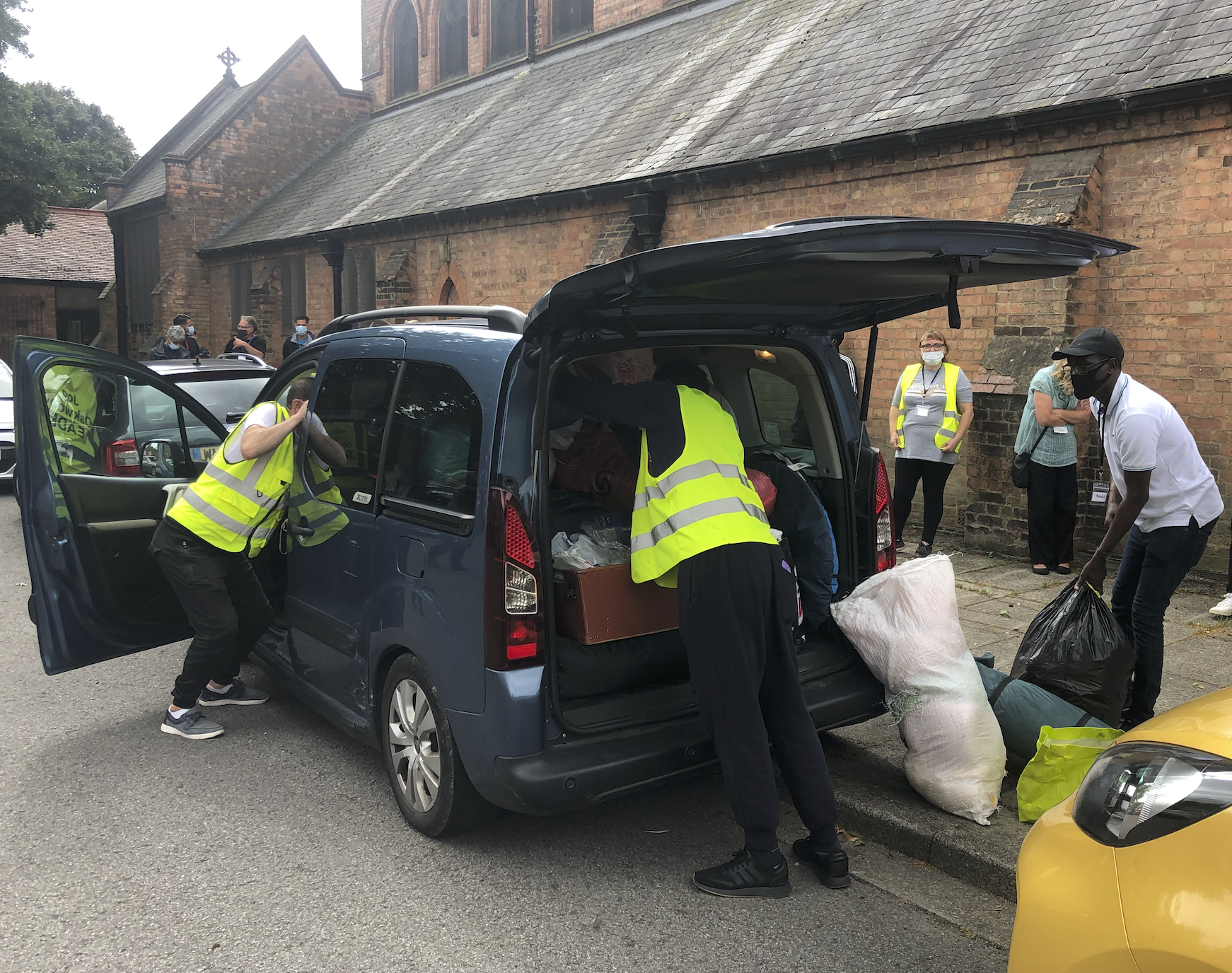
DRS volunteers loading the car with donations of clothing and sleeping bags
In France I had a minor panic as GoogleMaps wouldn’t work, so I phoned Dave who told me how to fix this in my phone settings. Ten minutes later we were at our Airbnb in Rue Auber, 1km from the old centre of Calais. That evening we walked into town and ate at Le Coq d’Or on Place des Armes.
Friday 7th August – Distribution at Calais BP, site of the former Jungle
We found a boulangerie and had baguette with cheese or jam for breakfast and drove to the C4C Warehouse at Bleriot Plage for 10am. The arrival drill is:
- Wash hands outside
- Check in on the tablet
- Put on a white C4C gilet
- Listen to the morning briefing, where everyone is assigned a job.
Several volunteers helped Jen and I unload the car onto the pallets for donations awaiting sorting at the entrance to the warehouse.

Incoming donations are unloaded onto pallets at the warehouse entrance, before being sorted for storage
I worked in a team of 5 volunteers to sort men’s coats for Saturday’s distribution at a site called Afghan Hospital where there are about 250 men and boys sleeping rough in the woods. The idea was to give out thick coats to use as a cover when sleeping, or a thin coat if preferred. With the police evictions, coats are more portable than sleeping bags.
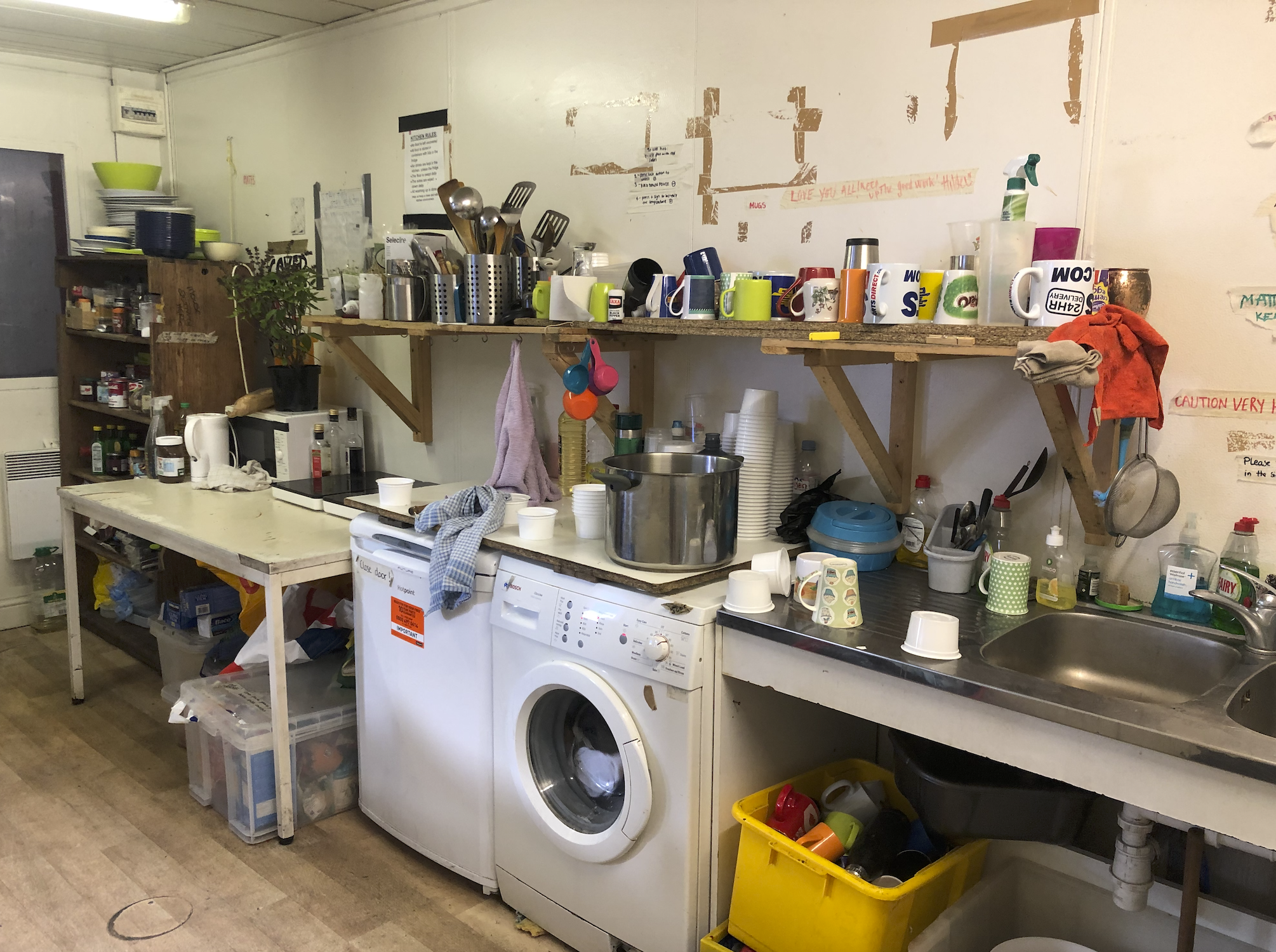
Out of this tiny kitchen came …
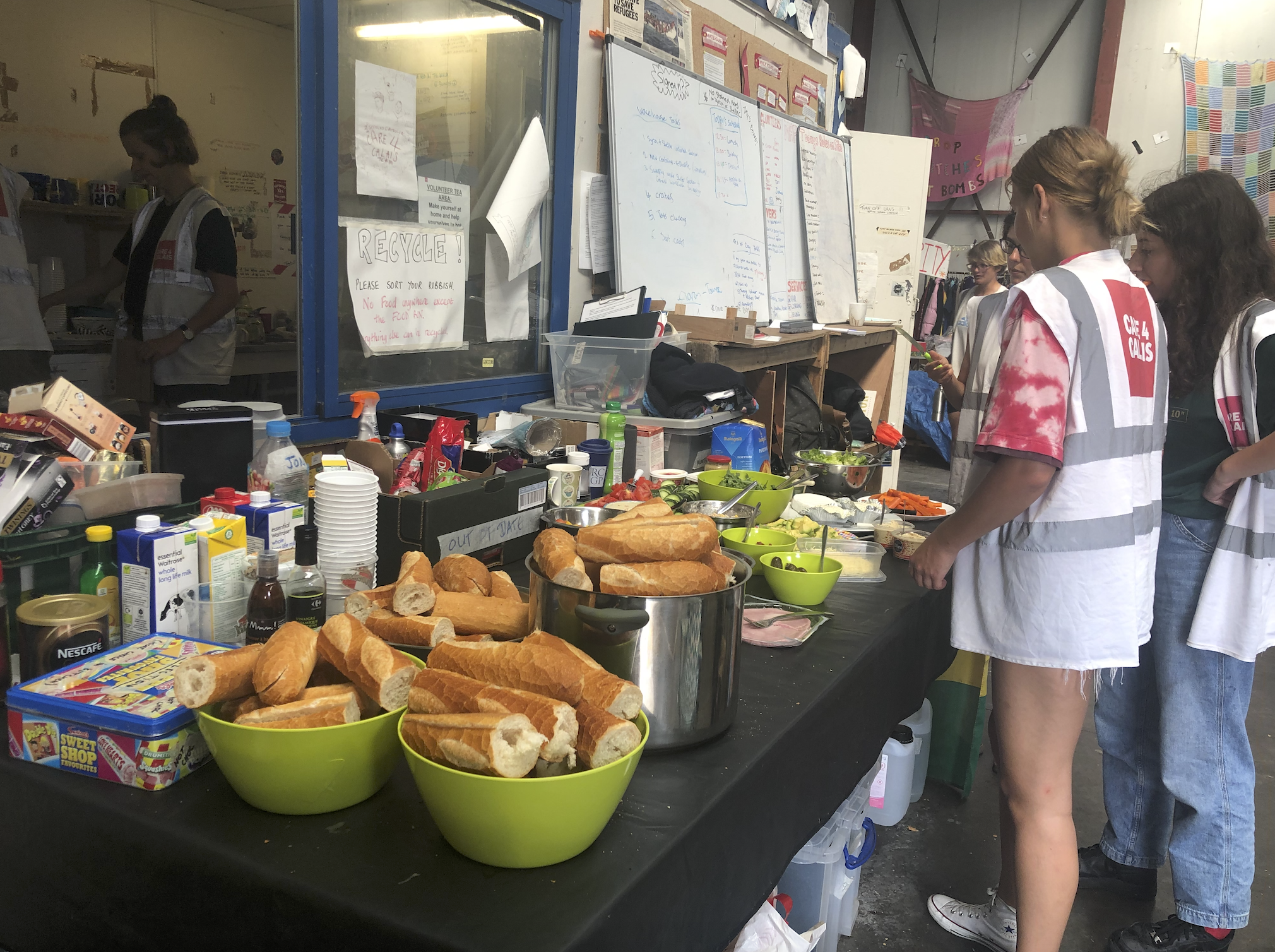
… many hearty lunches for volunteers!
Lunch – always prepared by volunteers in the small portacabin kitchen – was salad baguettes with hummus. The briefing for the afternoon’s distribution followed, we would be at a closed-down BP garage near the former Calais Jungle site, giving aid to Sudanese asylum seekers. Before we leave the warehouse, we must put on our PPE, which consists of British Airways pyjamas (navy cotton jersey, easy to wash) and two masks. As first-aider I also needed to pull back my hair, ensure my phone is fully charged and pack some essentials into a bumbag. We were included in a the volunteer WhatsApp group, and Beccy sent out the location of the distribution, so that the drivers can follow this on their SatNav. It’s not always possible to remain in convoy, with the multitude of roundabouts in the suburbs of Calais!
I can’t remember what was being given out that day – possibly coats – but the distribution must be carefully managed, as well as socially distanced. For this, we use small sports cones on the ground, spaced at 2 metres. The queue is monitored by about 4 volunteers to make sure nobody pushes in or queues twice. The coats are given out from the back of the van, and people are given a choice between 2 coats. If they don’t like either of them, a third and final one is offered.
After the distribution, Care 4 Calais offer several essential services, many of which were reduced during lockdown. These are the main opportunities for volunteers and asylum seekers to interact, as the distributions can be quite tense. Services include:
– phone charging via a generator
– bike maintenance,
– facilitation of hair cutting (3 chairs, shears, scissors, brushes and mirrors; asylum seekers cut each other’s hair)
– hot drinks and squash
– children’s play
– sewing – mending clothes and supplying patches for tents
– first aid, and
– games: cricket, handball or football.
As a retired nurse, I was to be on first aid, so had to top-up the crates used by the previous first aider with more bandages, etc. I was a little nervous, as you never quite know what injuries you’ll need to treat. But as an orienteering coach, I’d kept my first aid qualification up to date, so that gave my confidence a boost.
Underlying all the services is the opportunity to chat and interact with the asylum seekers. This shows interest and helps them practise their English, or French, as well as learning more about each other’s culture. It’s the most important part of what Care 4 Calais do. Merely giving out aid without interaction reinforces the asylum seekers’ status as victims. Adding dialogue transforms this into a conversation between equals. ‘Services’ is where this interaction happens naturally and often at some length.
That said, providing first aid was quite a hectic 2 hours for me – mainly treating lower-leg sores, which is quite time-consuming as the worse ones need to be thoroughly washed and dried, iodine gauze cut to size and applied, covered with a non-adhesive dressing for padding before applying a roll-bandage to keep the whole thing in place. The less ulcerating sores (simple cuts and blisters) could be treated with antiseptic gel and a plaster or hydrocolloid patch (Compeed equivalent). There were also cases of insect bites and sunburn.
I was just working on a groundsheet with a couple of camping chairs, and didn’t think to take things like a rubbish bin, so everything was a bit chaotic – but at least it left room for improvement!

Decontamination station!
Back at the warehouse, we washed our hands before washing everything down in soapy water and letting it dry in the sun. Then we removed our PPE which was put into bin-liners to go in the overworked C4C washing machine. Only when we are wearing our own clothes can we go back into the warehouse, where we have a cuppa and debrief, in which we discussed what went well, what didn’t and how it can be improved. Normally we finish at about 6pm.
Saturday 8th August – Afghan Hospital
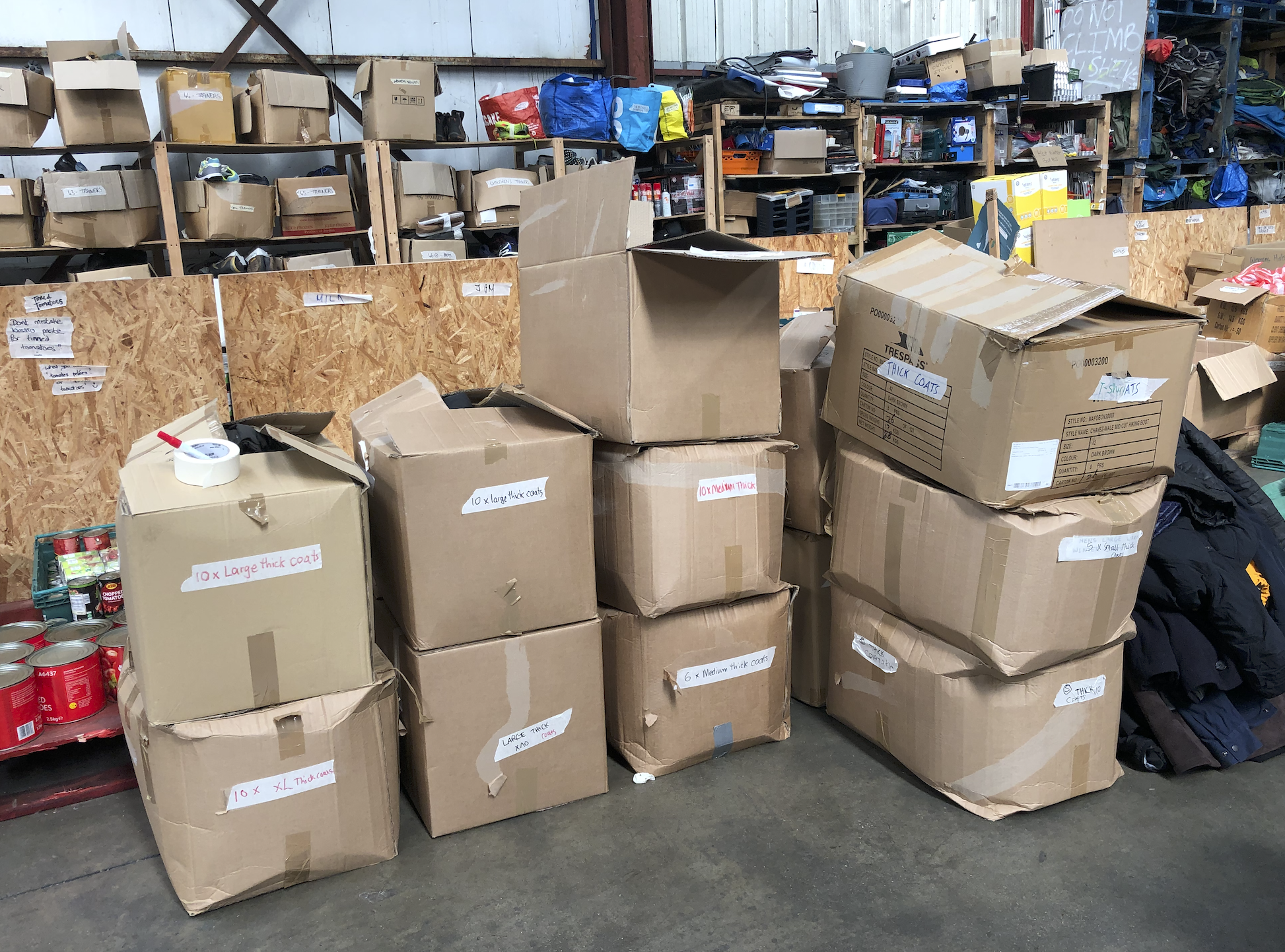
We finished prepping our coats: S, M, L, XL in both thick and thin to a total of 250 for the afternoon’s distro. After a hot lunch of ratatouille we listened to the briefing, and I asked if I could have a helper on first aid, and travel to the distribution site in my own car, so I could take more supplies and work out of the boot. This was fine, and I had room for 3 passengers. Clemmie was my helper and did a great job of opening the various dressings while I applied them. This is a real help from both a speed point of view, as well as infection control. It means that the first aider applying the dressings (dirty end) is not rummaging through the clean supplies. We treated about 20 gentlemen, mainly with leg ulcers and sunburn.

Sunday 9th August – Dunkerque
I left at 7am for a run and came back with our breakfast baguette. At the warehouse, I prepared the first aid kit for the afternoon’s visit to the Kurdish camp at Dunkerque, where there are families totalling about 100 people camping in the woods. I took sanitary towels, condoms, nappies, baby food etc as well as the usual kit, and Eleanor was my helper. She spoke to a lady with a 2 month old baby who thought she might be pregnant again, and was able to give her a pregnancy test.
Monday 10th August – Eritrean Camp at Calais BMX
Today we were doing distro at 2 sites:
- BMX for 100 Eritrean young men
- Old Lidl for 7 Afghani teenagers
First aid would be for the larger group, the Eritreans. Having a car meant that I could run various errands like taking volunteers to the railway station, which is what I did this morning for Griselda, there meeting C4C founder Clare Mosely who handed over a purse belonging to a French lady that a teenage asylum seeker had handed in. I took it to Andy (the warehouse manager), and we found the lady’s address on her permis de conduire. Griselda’s train was cancelled so I had to take her to Fréthun Station out of town near the Eurotunnel. I drove back via Coquelles where I stopped at a newsagent and pharmacy to buy some magazines and French equivalent Bonjela for mouth ulcers.

Tunnel boring equipment at a roundabout in Coquelles. Didn’t see anything like this in Kent!
The Eritrean camp looked very orderly, with tents in the shade of some small trees and 5 gallon water containers in a neat row. None of the Eritreans had leg ulcers, and I was told by another volunteer that it was because they didn’t fight amongst each other. Their soccer skills were amazing, considering they were wearing flip-flops.

Today we had a makeshift table, chairs for the patient, and even a rubbish bin. Basic housekeeping can go a long way!
The distribution today was of joggers or jeans. The team had boxed up 100 pairs of trousers in assorted sizes (mainly varieties of small). The Eritreans formed a socially-distanced line, standing by the cones we’d placed 2m apart. About 10 volunteers are needed to monitor the line and hand out the donated items in a fair and dignified manner. Line management requires concentration, a good memory, tact and firmness to spot and deal with people who jump the queue or join a second time. There are a series of hand signals to use for speedy long-distance communication:
- Arm raised with thumb and forefinger in O position: good, ready to start
- Arms raised above head, forearms crossed: there’s a problem
- Arms raised, hands doing winding motion: reel it in, i.e. evacuate quickly. This may be used if a fight breaks out, although I never saw one in the two weeks.
Once a person reaches second place in the line, they are asked if they want jogging bottoms or jeans, and this info is passed to the volunteer in the van who is opening the boxes. When they’re at the front of the line, our volunteer holds up two pairs of trousers, and they can choose one. If they don’t like either, one is swapped out for a different pair and they are encouraged to choose one. If neither pair still suits, they’re given a third and final option.
There was reggae music playing at the distro, so it made it difficult to hear what people were saying, but we muddled through. One boy came to me with an extremely red left eye. I had no eyedrops, so I agreed to come back with some at 9am the following morning. Fortunately, I built up a small shopping list for other people in the morning, so I wouldn’t be seeing the boy on my own. Also, there were women in the camp, so I’d be able to bring a supply of sanitary towels.
I showed the boy with the red eye how to play noughts and crosses as well as squares. He told me he’s been in Germany for three years before coming to Calais, and that it was his dream to go to Liverpool and train to be a nurse. His name is S.

Other patients today came with blisters and fungal cuts between their toes for which I applied Sudocrem. We try and give out enough cream and dressings so that patients can re-dress their wounds a couple of days later.
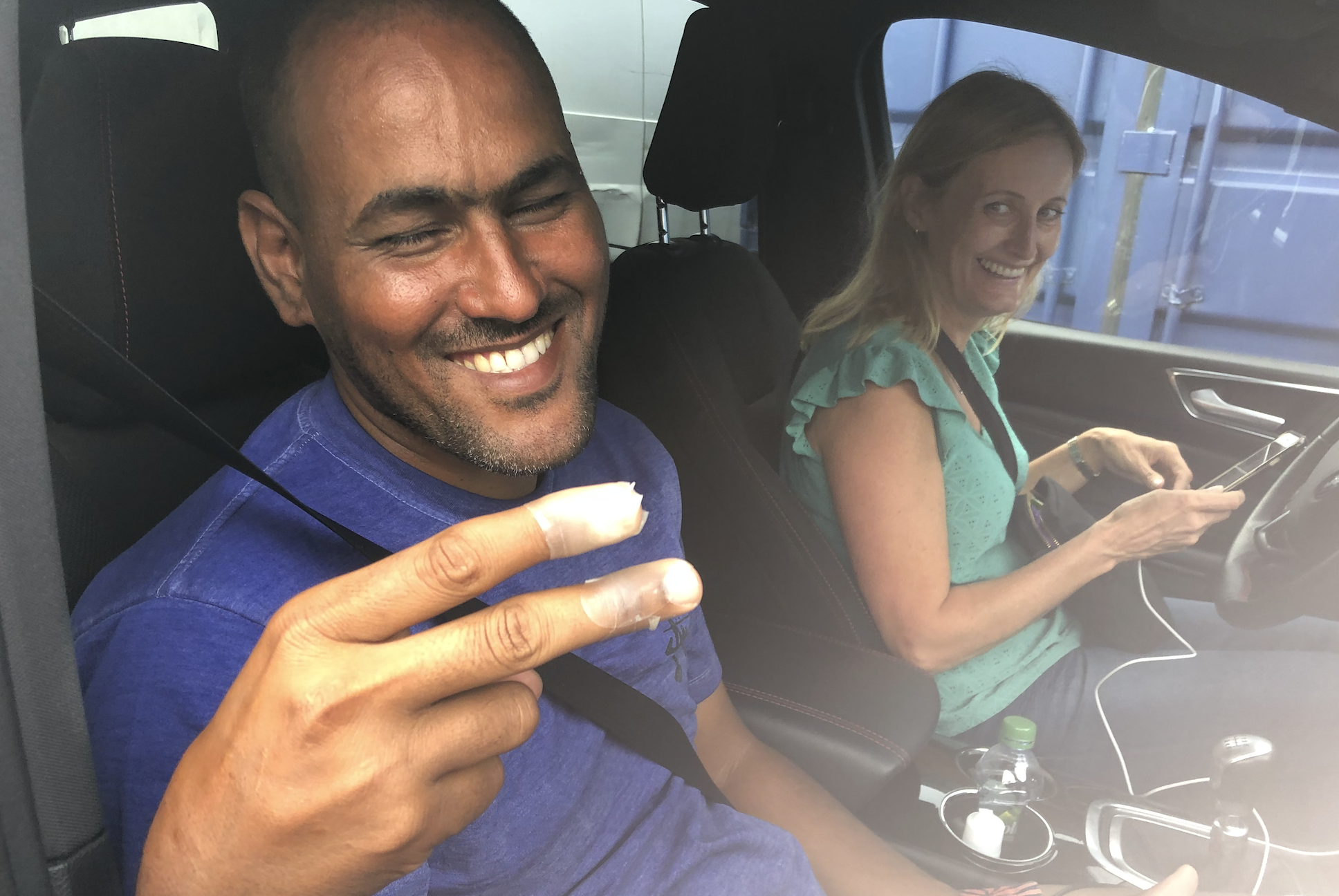
Clare Mosely with Siddi – happy with his rowing blisters covered.
During debrief, I was called to Clare’s car to treat a gentleman called Siddi who had blisters from rowing across the Channel. Hydrocolloid plasters to the rescue once again. I later learnt that Siddi had, on another occasion, jumped overboard to prevent the boat from sinking.
Clare Mosely is the founder of Care 4 Calais. A former accountant from Liverpool, she was moved to volunteer in September 2015 and has remained in Calais since then.
Tuesday 11th August – Litter pick at Old Lidl and an afternoon in the warehouse
Today was an early start so I could get to the pharmacy for 8am to buy eyedrops. I’d assembled the other items to take to the Eritrean camp from the warehouse the evening before: moisturiser, insect repellent, condoms, elastic for a repair and S’s eye drops. I’d also got a Michael Morpurgo novel for S to read to practise his English.
The meet-up was successful and I applied S’s eyedrops and gave him instructions for applying them himself. I was at the warehouse just before 10am.
On Tuesdays, the distribution is normally at Brussels, but two Red Cross volunteers recently tested positive for Covid 19, so the distribution there was suspended for 2 weeks, pending review.
Yesterday the group who went on distro to Old Lidl reported that the asylum seekers there had moved on (or maybe even crossed the Channel to England) and that the site needed cleaning. Armed with rakes, heavy duty gloves and bin bags, about 12 of us went along in the minibus, driven by Simon from London. We did quite a good job, filling 27 bin liners, which we left by the council van for their workers to remove. Rakes were useful, as much had been trodden into the sandy ground. We cleared plastic cups, masks, hand sanitiser bottles, remains of tents, and bags of fermenting baguettes that made my stomach heave.
We were going to take before- and after- photos, but as Jen pointed out, this could be used by some media to make the asylum seekers look bad.
After a lovely hot lunch of pasta with tomatoes and olives, we were assigned various jobs in the warehouse. Some things can be very time-consuming, such as checking that tents have all the correct parts and carrying out any repairs that are needed. I was topping up the first aid kit, then moved onto making up food packs. We finished at 5:15 and had a lovely swim in the sea, at Blériot Plage just across from the campsite. Louis Blériot had made the first cross-Channel flight from there in 1909.
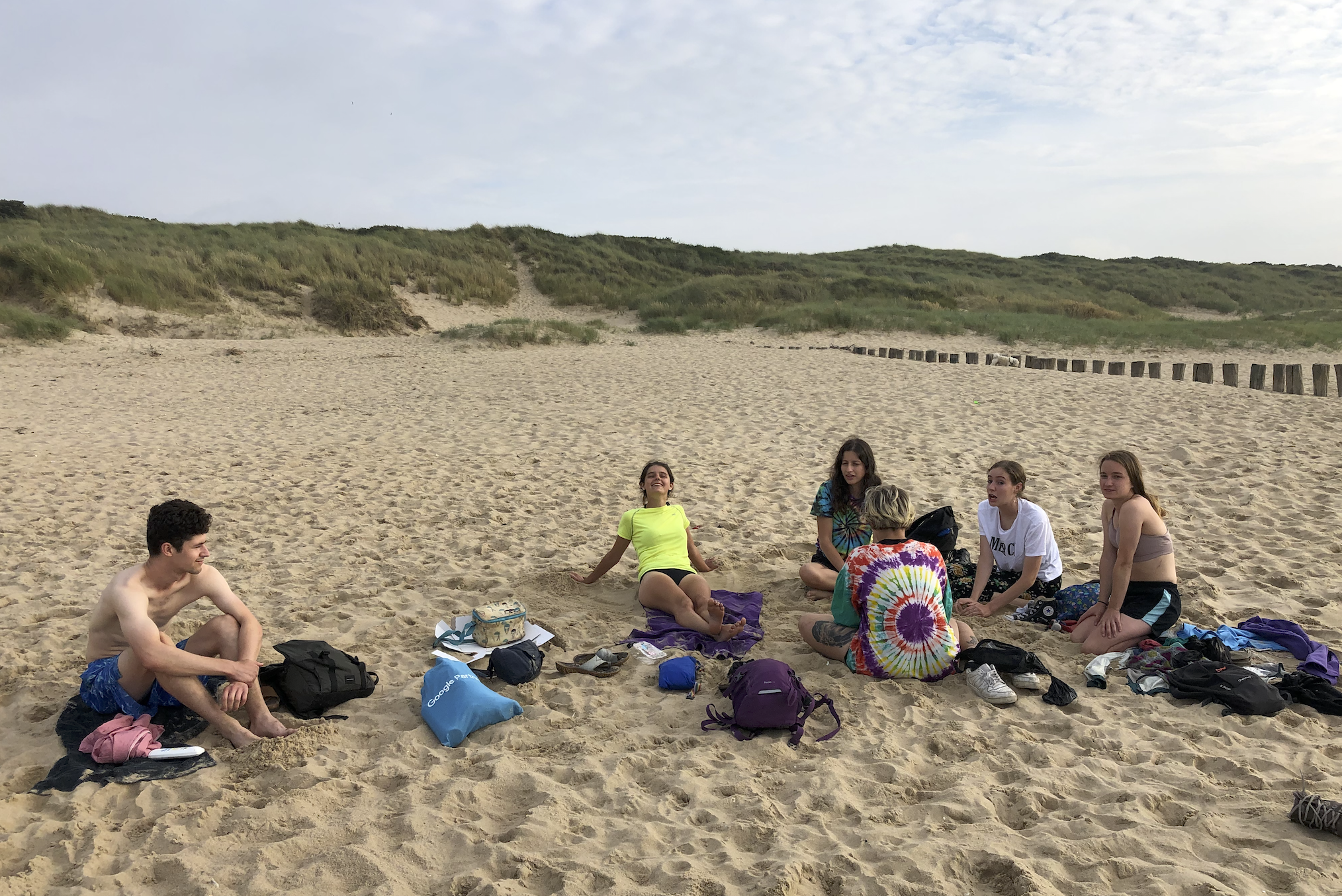
Unwinding at Blériot Plage, just across the road from the C4C warehouse
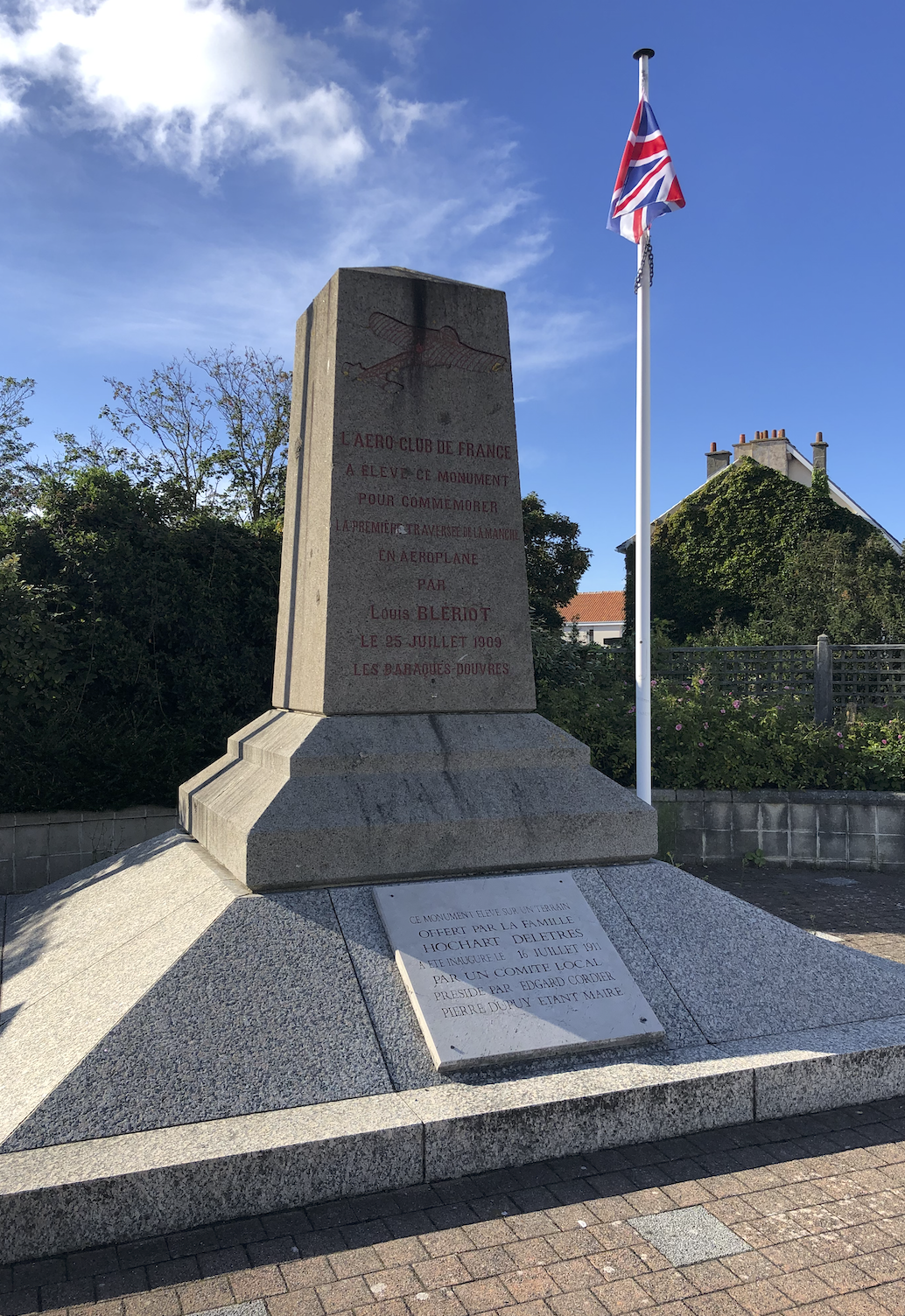
Monument to Louis Blériot’s cross-Channel flight, 25 July 1909
Wednesday 12th August – Food-pack distribution at Afghan Hospital
Today we assembled about 500 large food packs of meals for 4 people. I found boxes of vitamin tablets with expiry dates later in the month, so we boxed up 250 of them to give out with the food packs. Out-of-date food and medicine – although likely to be fine – can’t be given as aid as it gives the wrong message. I was pleased that the vitamins were being given out, as micronutrients are important for would healing.
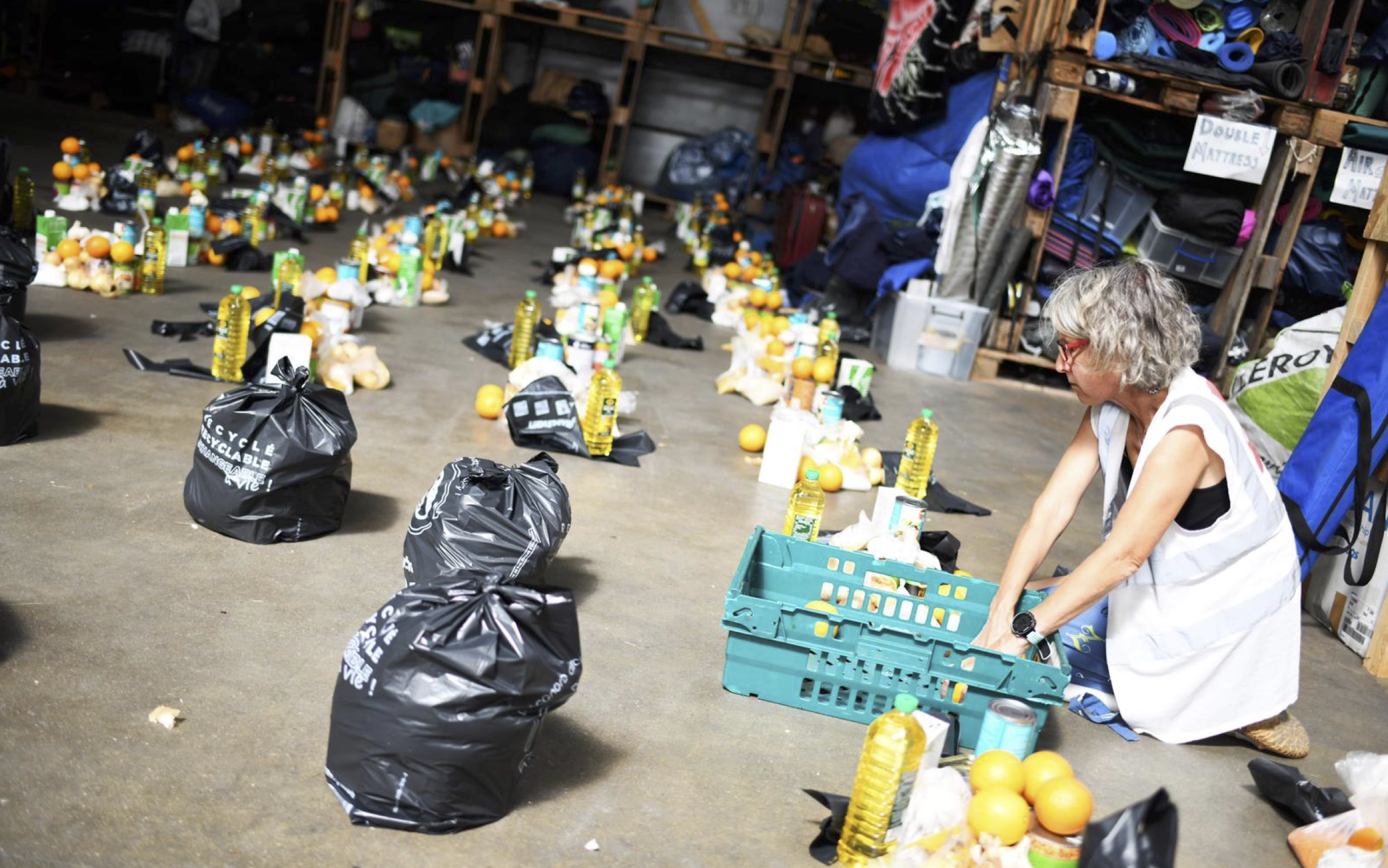
These food packs provided meals for 4 people for 3 nights and cost roughly €10
Thursday 13th August – Dunkerque
I made a diversion to Auchan on the way to the warehouse to buy some French novels. At the morning briefing, we heard that the police had evicted the Dunkerque camp during the night, bulldozing some of the trees where their tents were pitched. Today was our day to visit, so I packed lots of mother and baby items, including a travel cot.
Because of the eviction, some volunteers were assigned to looking in the forest for any dispersed Kurdish asylum seekers. However, when we arrived on site, some were there waiting for us, and put the message out to their friends that we’d arrived.
Eleanor sought out the lady to whom she’d given the pregnancy test, and the result was positive. Thoughtfully, Eleanor had bought her some antenatal vitamins with her own money.
On first-aid duty I was helped by Henry and Jemima. We treated lots of people with foot problems and insect bites, for which we give out ointment and antihistamines. A Pakistani gentleman translated for us. Later he showed us photos of his homeland in the beautiful Swat Valley in the Himalayas. The travel cot was gratefully received.

It’s so heartbreaking that police evict the asylum seekers so often. I’m not sure how many days the family would have been able to use this cot before the next eviction.
Friday 14th August – Distribution at Calais BP
Calais BP is the site of the former Jungle camp, disbanded in October 2016 and home to some 7000 asylum seekers. Now there are about 80 Africans there, from Sudan, Ethiopia, Chad and Niger.
The distribution was of tarps and blankets. The tarps are attached to fences by the road where the asylum seekers try to sleep. Even in August, the rain storms are heavy, and these would have provided only meagre shelter.

Distribution of tarps and blankets at Calais BP, with police are looming the background
Saturday 15th August – Day off
Eleanor and I met at my Airbnb at 10:30, then drove to Sangatte to start our 11km run along the coast to Wissant via Cap Blanc Nez. It was a bit misty, but good conditions for running.
At Wissant we had a nice lunch at a restaurant, then eventually managed to find the beach and walked 9km back to Sangatte, as the tide was just out far enough.
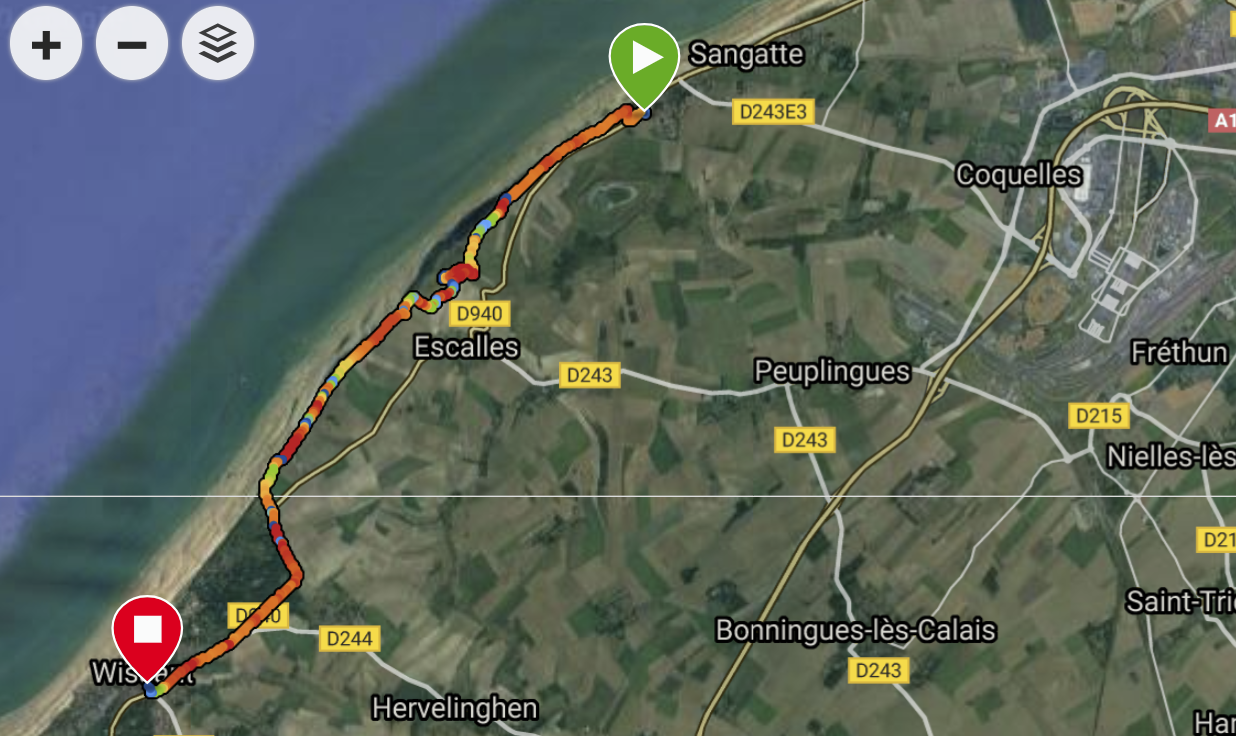
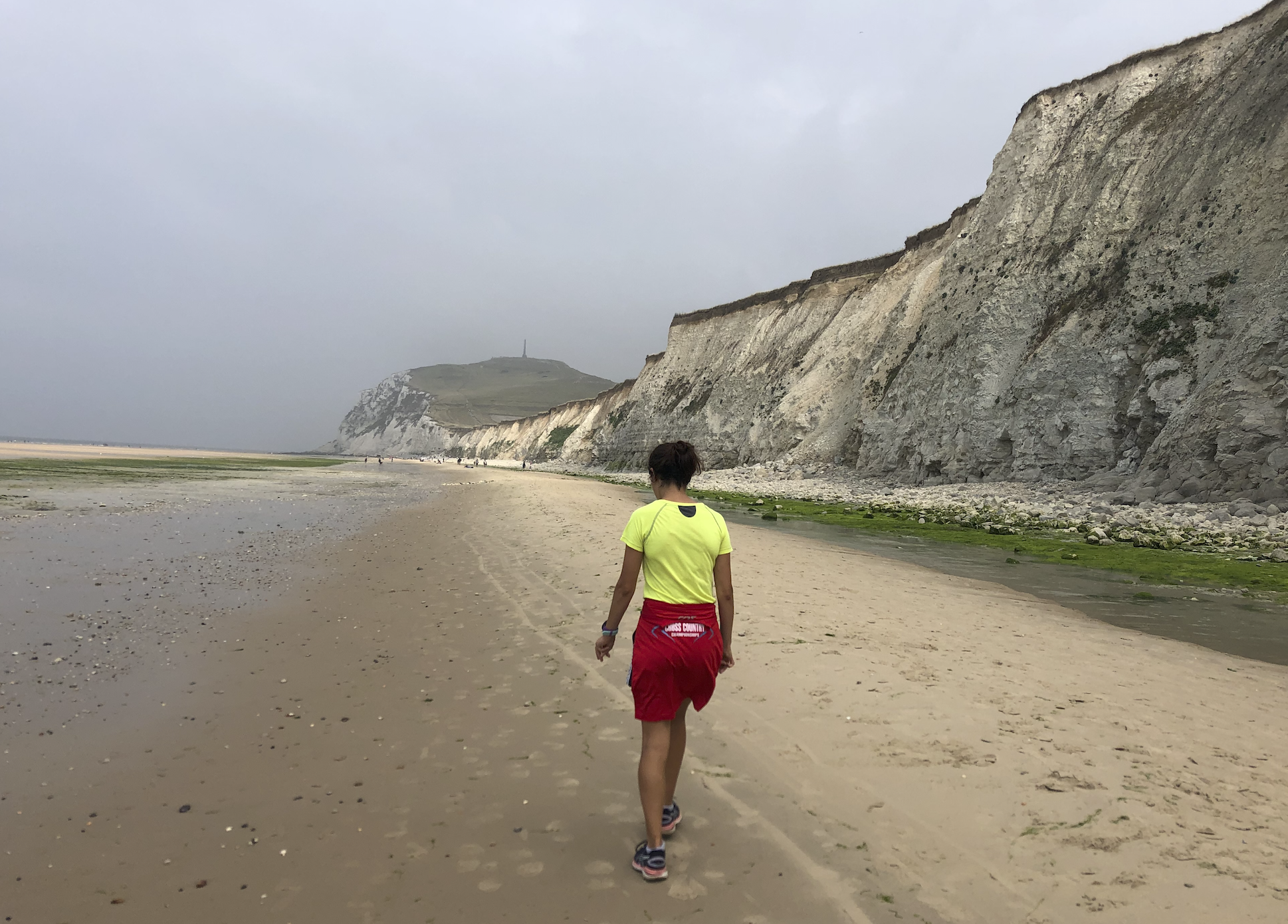
Eleanor walking back towards Calais, with Cap Blanc Nez
After a quick shower, we me some of the other volunteers at the beach, after their shift. Jemima was off for a short break in Paris. She had a swim with the others, and then I drove her to Fréthun Station.
At the Airbnb, I had a jam baguette (fine after my steak lunch) and walked to the Family Pub where I was lucky to meet the Dutch couple who founded FAST – First Aid Support Team. They met in Calais, and are now married. C4C allow them use of a container on their site for free. Normally a container would cost €1100 to buy with €1 a day in ground rent.
Jonathan kindly walked Anne and I back to my flat, and Anne stayed the night.
Sunday 16th August – Distribution at Dunkerque
I made Anne some porridge and had an opportunity to look at the war graves – both French and Commonwealth – at the Calais Sud Cimetière near Anne’s Airbnb while she collected her things for the shift.
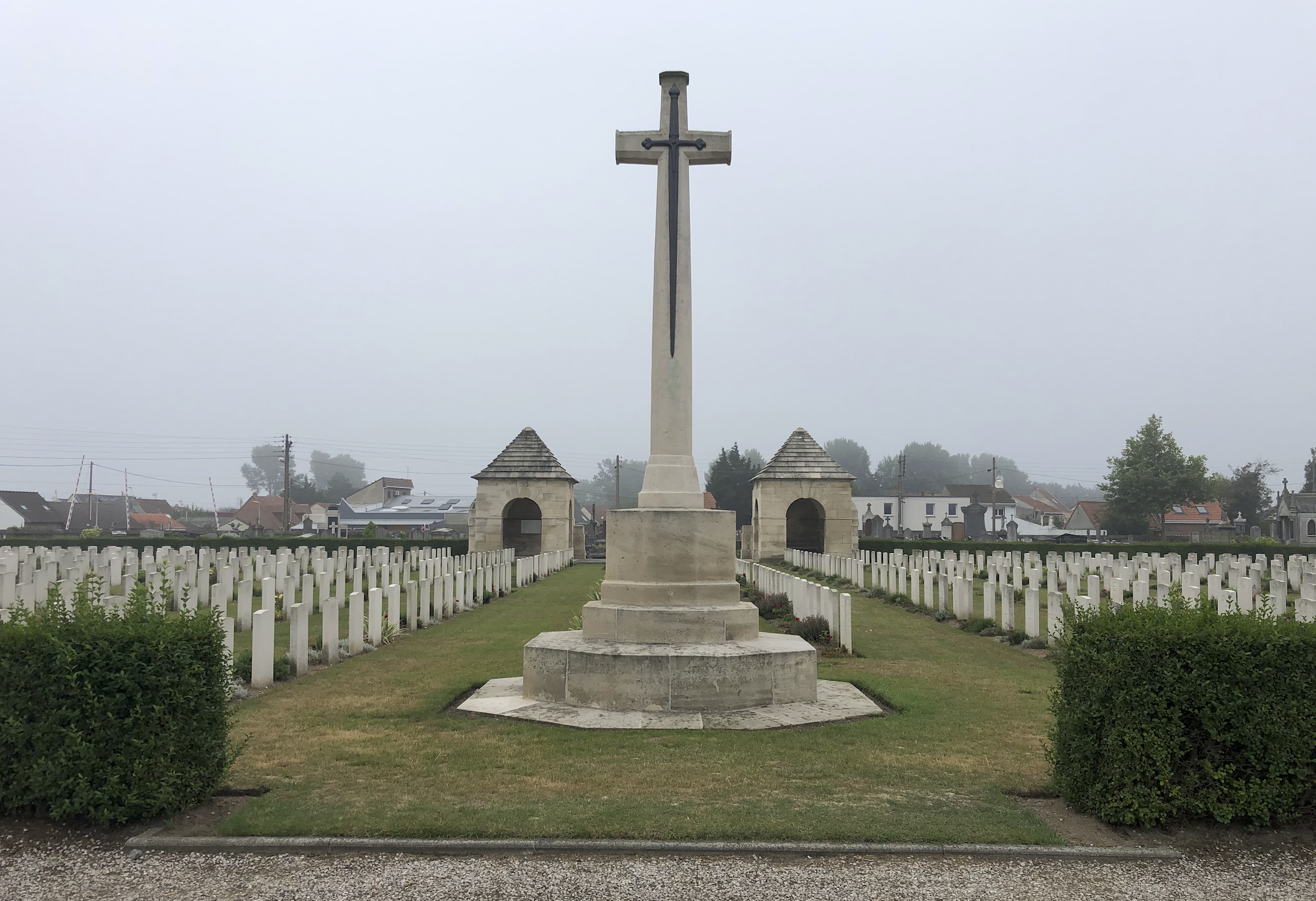
Commonwealth war graves at Calais South Cemetery

French war graves at the same cemetery
Now that Noleen from FAST was doing first-aid, I was free to do other warehouse duties, so I pegged the washing on the line, mopped the kitchen floor, then helped Anne do the hot drinks prep for the mini-visit to BP this morning with just hot drinks and phone charging. The hot drinks are “pre-cupped” into coffee, green tea, black tea and chocolate, then fixed with masking tape. An empty cup is added to protect the top drink – as I found to my cost, when the granules in my top cup stuck to the tape!
Later we finished making up 100 male hygiene packs with Sophie, Flora and Isaac. I knew Dave and Zoë were passing at 1pm to get the Shuttle, so I asked if it was ok for them to drop in for a tour. This was nice as they were able to see the warehouse and meet Jen quickly.
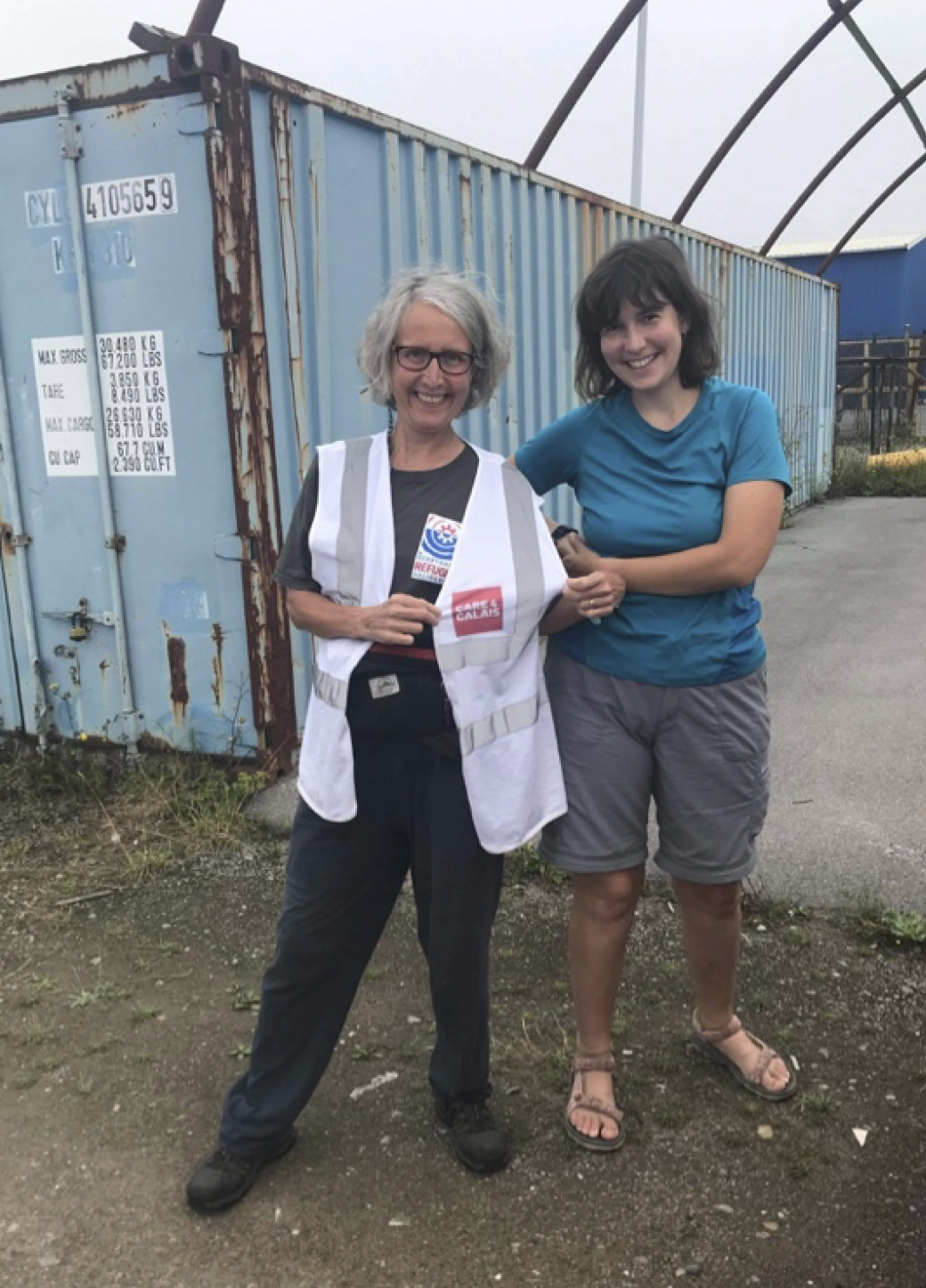
Meeting Dave and Zoe briefly (got to get those logos showing properly)!
We left for Dunkerque at 2pm. I did hot drinks and then some scaled-down first-aid with the kit that was in the minibus. One gentleman with lower leg sores I treated the previous week with paraffin gauze and bandages was now much better and only needed 4 hydrocolloid patches – impressive healing, but he is young and mobile.
There was a heavy thunder storm, so I treated another couple of people who had blisters under the cover of my car boot. Fortunately a volunteer was on hand to pull a tarpaulin over the 100 phone charger pallet powered by our generator.
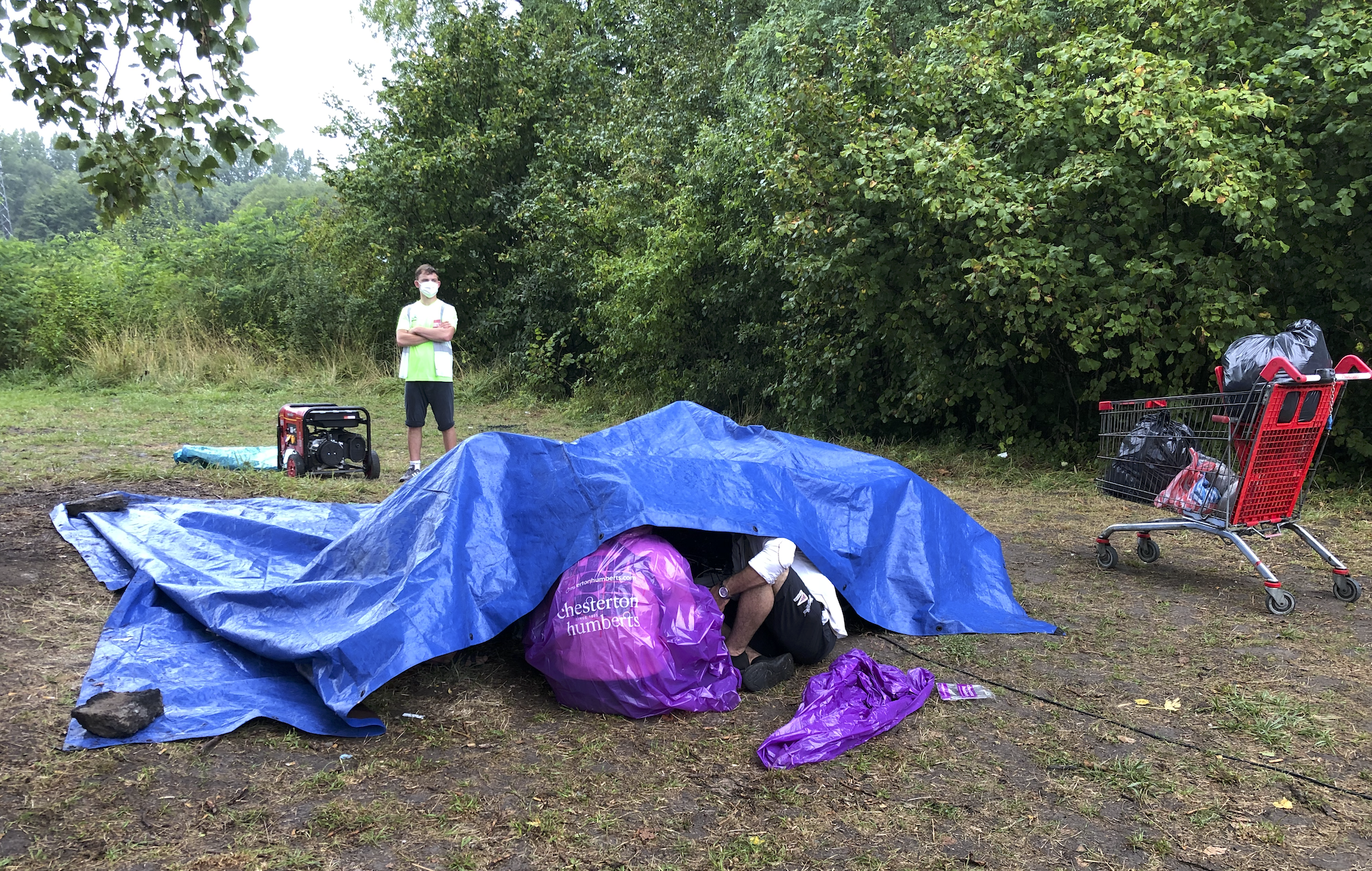
Phone charging in a rain storm – 10 x 10-socket chargers attached to a pallet and powered by a generator
Anne came for tea and we had omelette and pasta, then I dropped her off at hers and had an early night.
Monday 17th August – Distribution at BMX
Got to the warehouse at 9:40, hung out the washing and helped prepare the hot drinks for the afternoon’s distro. Then I packed the car for first aid at BMX, where there are men, women and teenagers, so I needed to include condoms and sanitary towels.
I spent some time washing plastic bottles and finding matching lids so that they can be used for filling with cooking oil as part of a food-pack. Items are re-used many times at Care 4 Calais, and little is wasted. Having said that, going to the déchetterie or tip was a job assigned to two volunteers every other day. I missed this outing, but I was delighted when Finn asked me to “take me to Decathlon, and step on it” for bike parts at about noon, and took the opportunity to buy myself some sports-glasses straps. Unfortunately I got two speeding tickets when I got home – both from separate runs to Dunkerque (note to self).
Sophie cooked an amazing lunch of dahl, rice, spinach leaves and melon, then we donned our PPE and drove to BMX. There were sudden heavy showers, so once again the tarpaulin was needed for the pallet with all the phone chargers!
I did first-aid “largely foot care and small wounds healing wonderfully under the circumstances” I wrote in my diary. I spoke to Safi – an Afghan refugee who was in the Jungle in 2016 – and Shona, who work for the Refugee Youth Service. They had a table set up with games, and here I met S again (the teenager from the week before, to whom I gave the eyedrops). His eye was now pale pink, and he’d been reading bits of the Michael Morpurgo novel Kensuke’s Kingdom. I left him my phone number and sent him a Friend request on Facebook.
The distro today was of jumpers (120) and I was on line monitoring. Any problems were soon sorted by retired-teacher and warehouse-manager Andy. I leant my phone charger to an asylum seeker called Philomon, and he returned it to me 10 minutes before we left.
Tuesday 18th August – Warehouse day instead of going to Brussels
Today was a day of shopping for and making-up of food packs. The first job was splitting 10kg bags of red lentils. A pint-capacity Sports Direct mug filled to the brim holds 500g, which need to be bagged to go in the food pack. It was a messy job, carried out on a tarpaulin on the cold warehouse floor, but the repetitiveness made it feel quite meditative.
In addition to the lentils, the packs contained:
1 litre cooking oil
2 tins tomatoes
Tuna, large tin
Halal chicken, tin
2 tins chick peas
500g pasta or rice
5 onions
1 garlic bulb
50 tea bags
200g sugar
1 litre UHT milk
Salt, spices
4 oranges
The food pack feeds 4 people, I thought it was for one meal (and quite generous), but I later learnt it was for three meals. I guess one day the protein component would be pulses, the next tuna and then chicken. The only way that would have provided adequate calories (for 12 adult main meals) would have been to use every last bit of the cooking oil. I can’t comment about the other nutrients – but compromises have to be made as each pack costs just €10, and all C4C’s funding is through donations.

It was a massive team effort to assemble these food packs – worth €10 each, and intended to provide 3 hot meals for 4 people
Finn and I went to Auchan to buy 522 oranges and 160 bulbs of garlic for the packs. The oranges came in 3kg nets, each containing 14 oranges. I emptied the shelf then asked a staff member for 27 more bags (37 bags in total). All the staff were really helpful, but the bill for the oranges alone was €259.
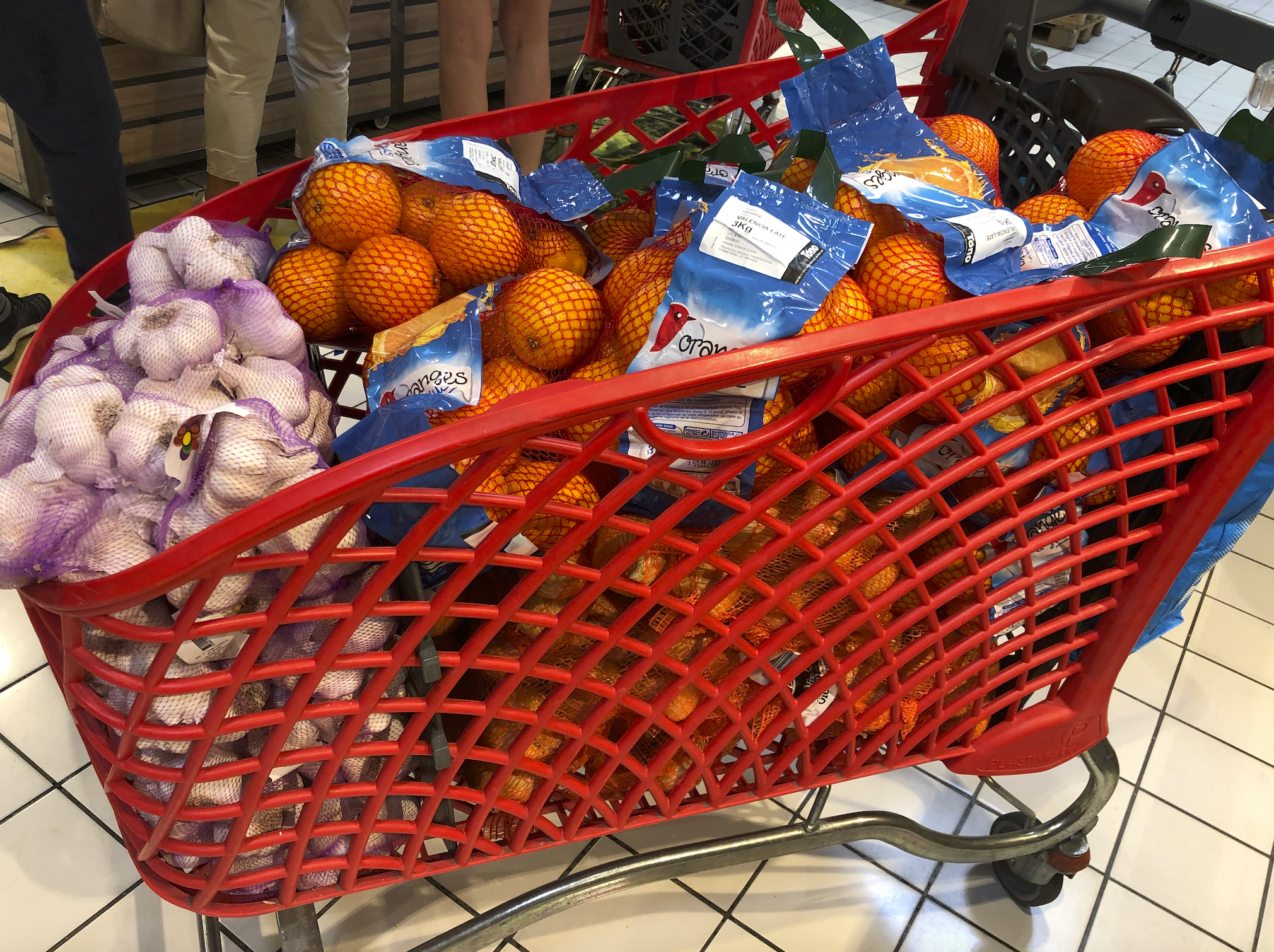
Garlic bulbs (pretty huge in France), and oranges, sterile until peeled. Expensive – but an important component of the food packs
The packs were arranged in rows on the warehouse floor, item by item, and, when complete, were bagged up, with the heaviest items on the bottom.
Finn made paella for lunch and we loaded the food packs in the afternoon and we had an early finish at 5pm. We went to the beach, and I was able to explore one or two of the graffitied WWII bunkers. I dropped a car load of sandy volunteers at The Family Pub, then drove the car back to my flat where I met Eleanor and we walked back into town. Had coq au vin with chips for €16, then we went to the Betterave bar round the corner for Ciaran’s birthday and played Rummikub. Anne slept at my flat again.
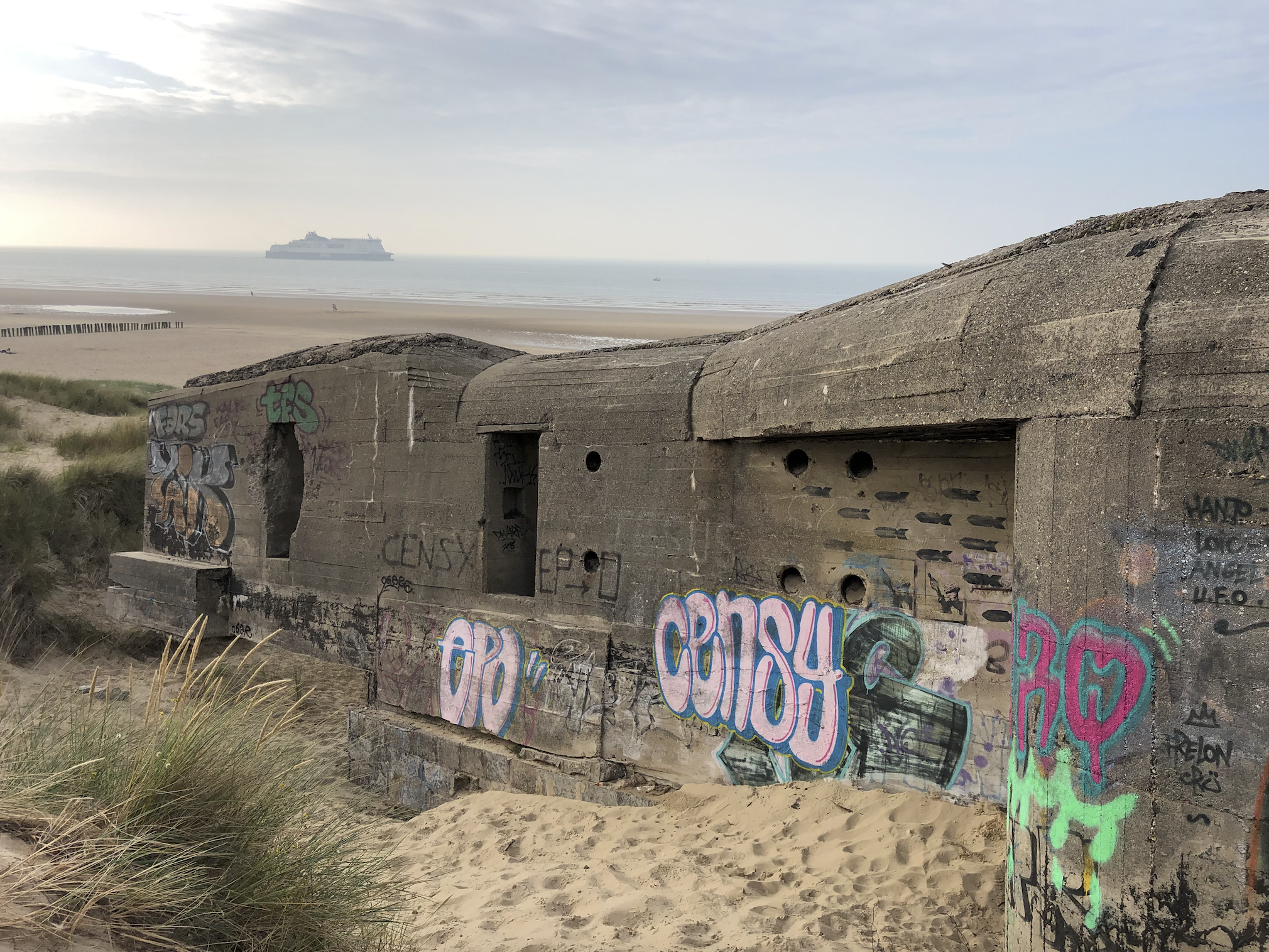
One of many hundreds of bunkers that formed part of Hitler’s ‘Atlantic Wall’ built between 1942 and 1944
Wednesday 19th August – Morning off, then Afghan Hospital
I collected Alex from her Airbnb near the railway station and we had a look round the book section of Auchan and a coffee before meeting Jen. Then we went to Le Channel Arts Centre and bookshop in a former abattoir, before attempting to visit the Auberge des Migrants (another aid charity). Unfortunately I took the wrong exit at a roundabout, and we ended up on the peage for Paris, unable to turn round for 17km, and then having to pay a €4.50 toll! We said a quick hello at the Auberge and got some info about their working hours, then went back to the warehouse for a lunch of tomato baguette.
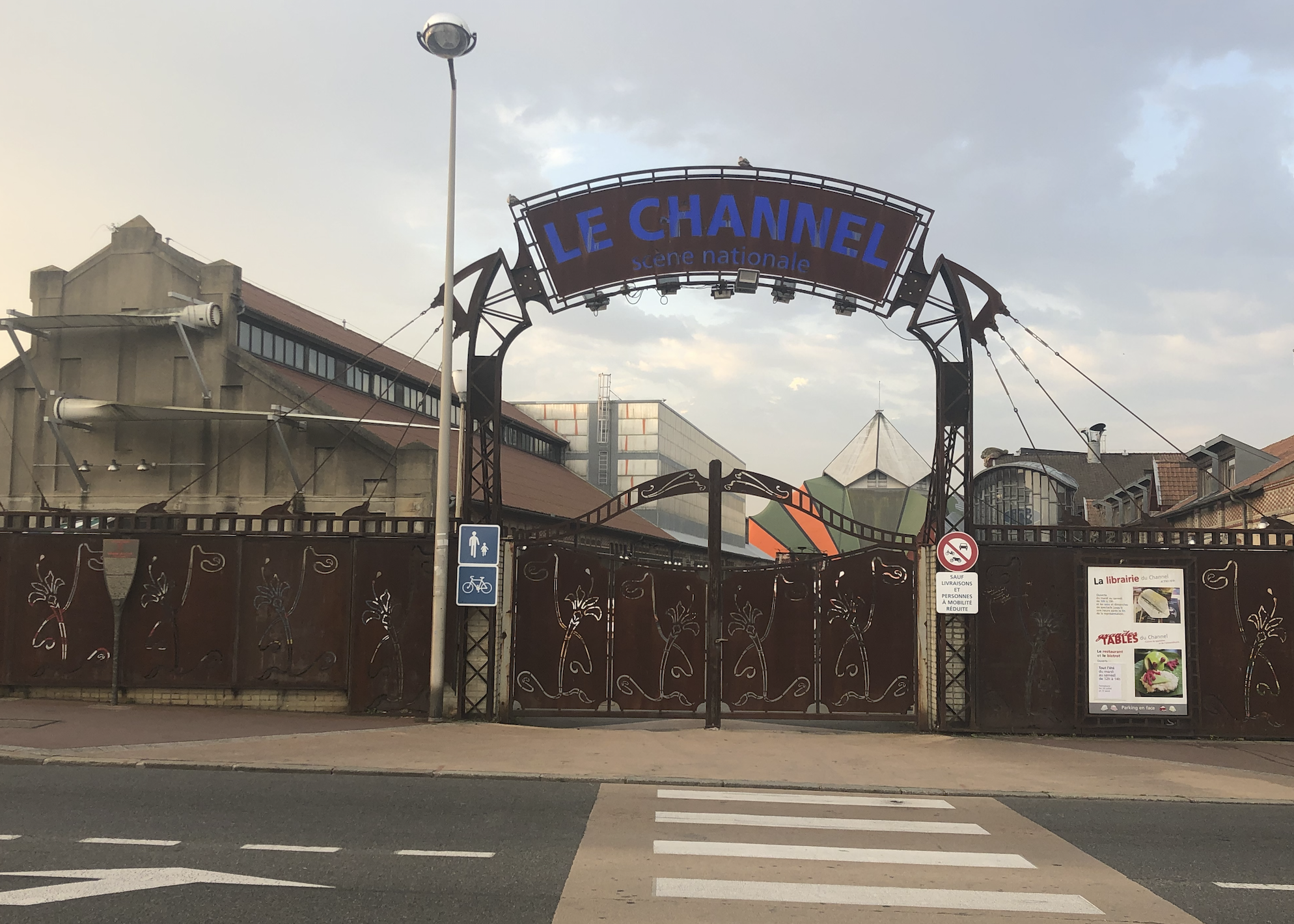
Le Channel – performance space and arts centre in a former abattoir. But all that was open during lockdown was the bookshop.
Andy broke the news to us that the body of a Sudanese asylum seeker had been washed ashore at Sangatte early that morning. He had been trying to cross the Channel on a small boat at night with a friend, who was rescued and was now in hospital in Calais. Tears were shed, as we paused for a minute to reflect on the young man’s bravery and dignity.
In the afternoon, we were distributing the food packs we’d made up yesterday. The asylum seekers had to line up in groups of 4, so we had to be strict when they arrived in 2s or 3s and merge some groups. Sports mini-cones on the ground were useful markers.
I helped Sarah with sewing, mending the coat of an Afghan boy. Coats often fail under the arm, and it seems that this had happened before because the boy insisted in threading my needle with four strands of cotton, instead of the usual two. He had wristbands in the colours of the Afghan flag (red, green and black), and we practised the English words for them. Another asylum seeker called Moro brought Sarah and I a coffee, which was really thoughtful and much appreciated.
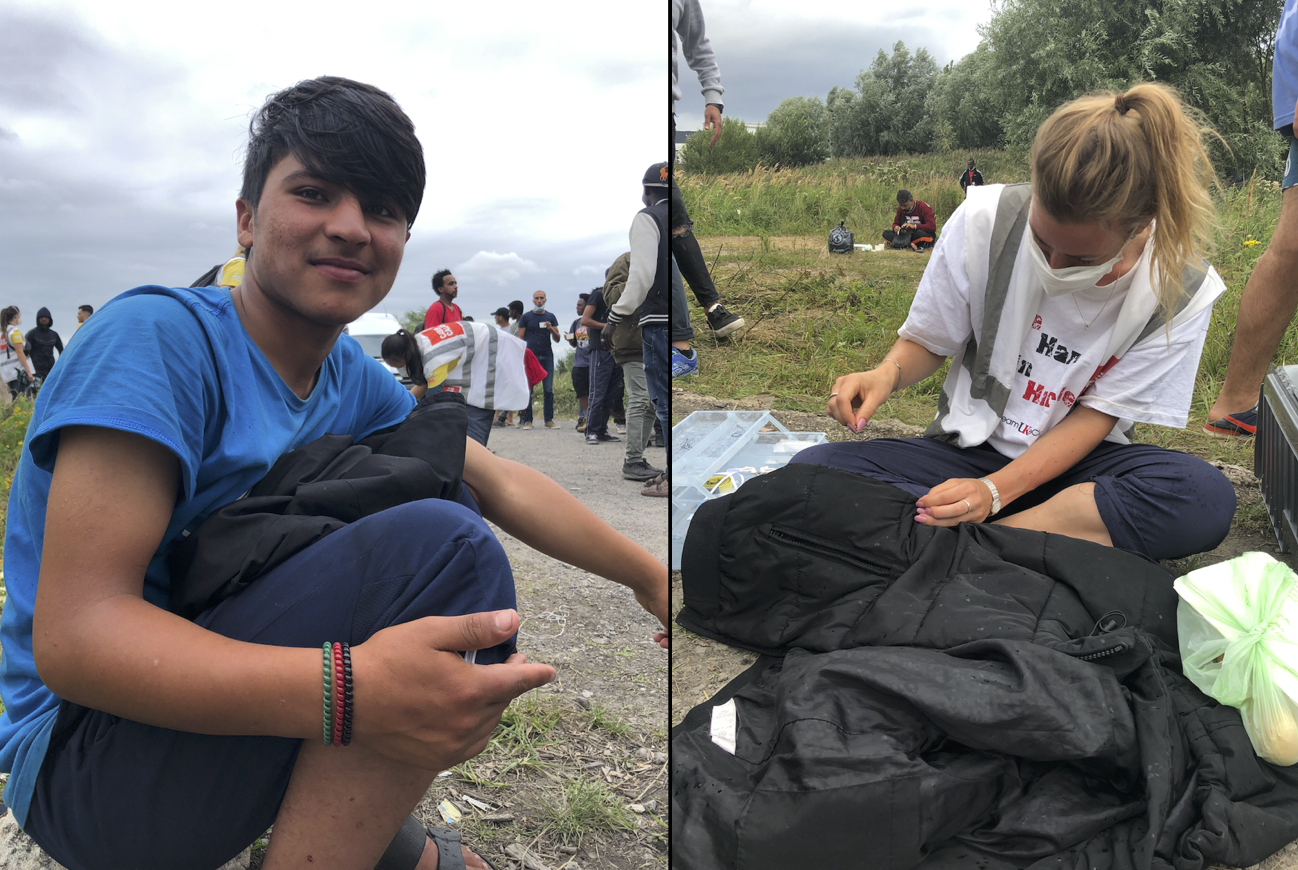
This boy from Afghanistan was keen to have the under-arm rip in his coat mended, while we practised the English names for the colours of the Afghan flag on his wrist bands
This gave me the idea to procure a coffee for Noleen, busy on first-aid, who also appreciated it! I was then called back to sewing, as a queue had formed. An Ethiopian gentleman needed some trousers hemming – a lengthy job when sewing by hand. They were very high-quality shower-repellent fleece-lined trousers, and he was keen to have them altered. We pinned them to the correct length and started sewing and chatting. His English was excellent and he told me he had worked in marketing in Addis Ababa. He left Ethiopia in 2005 (we never ask why), and came through Niger, Libya and Italy. His friend had a physics degree and worked as a bus driver for Ethiopian Airlines. By now it was raining torrentially and we’d retreated to sew under the boot of my car, me hemming the right leg and the marketer hemming the left one!

Taking up trousers for a gentleman from Addis Ababa who had worked in marketing
Back at the warehouse, I’d made the mistake of leaving my clothes outside in a bag, and they were sodden, so I had to but a shirt from the C4C charity shop – a corner of the warehouse where clothes not appropriate for asylum seekers are sold. Some clothes aren’t appropriate for the weather conditions, or are too conspicuous to the police. These can be sold to volunteers to raise much-needed funds.
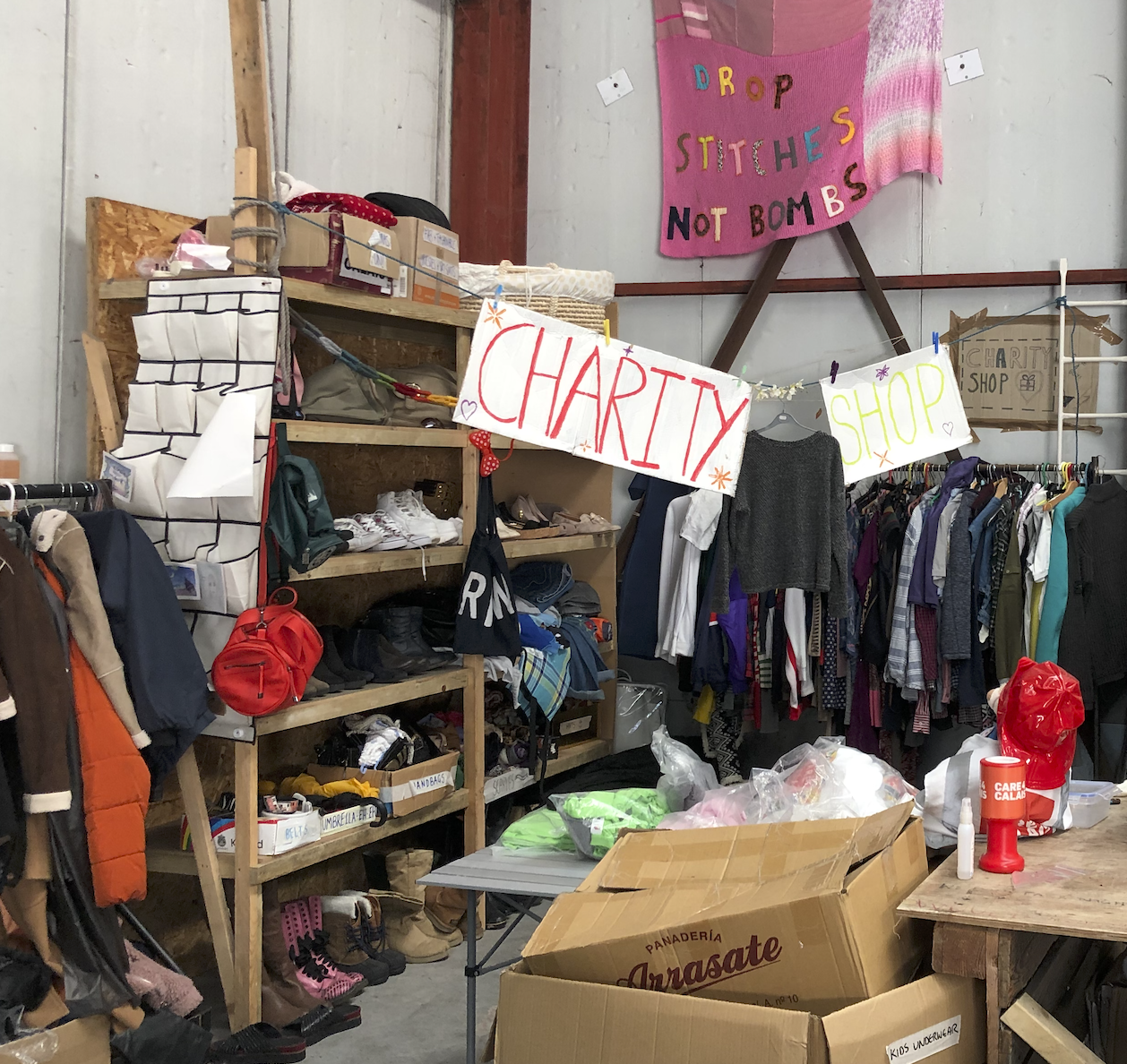
Clothes not suitable for asylum seekers, or that might raise more cash, are available for volunteers to buy
Because of the continuing rain, I dropped a couple of volunteers off on my way back to the flat, cooked, then later went to Eleanor’s Airbnb for a night in with a few of us plus Jonathan and his guitar.
Thursday 20th August – Dunkerque
Today was my last day in Calais, and Jen and I wanted to be able to say our goodbyes as well as getting some French groceries to take home, not least wine. At the 10am briefing, I offered to shop for and prepare lunch. This would allow me to complete at least the food part of my grocery shop at the same time at Auchan.
We were on a tight schedule as Dunkerque is a 35 minute drive from the warehouse, and a vigil had been arranged at 18:30 on Rue Royale for the teenager who had drowned the previous morning. Andy therefore asked me to make a quick cold lunch of baguettes.
I asked 2 or 3 people what their favourite filling was, and made a shopping list. There’s just one C4C credit card, and it was out with the group doing the Thursday BP mini-visit. By 11:00, I realised I was running out of time to shop and prep the meal, so I decided to use my credit card, which meant that I could include family shopping too.
I took a pile of bags for life to separate the C4C lunch and my personal items. Tim told me that the 6 new arrivals that day were all omnivores, so it would be good to include some ham, as well as the usual cheese and salad.
I found most things and got back for 12:00, recruiting Eleanor and Vanessa as my prep assistants, while I arranged the table and labelled the vegan food. Unfortunately, I left 2 bags of tomatoes I’d payed for at the checkout, so had to apologise to everyone for this!
Swift on the heels of lunch was distro briefing and task allocation. The distro was 120 large food packs. I volunteered to help Rebecca from Taiwan on sewing as I always enjoy this role. We quickly donned our PPE and leapt into our allocated vehicles.
We arrived at the country park in Dunkerque, where the migrants were camping in the trees. A week ago, their part of the woods had been felled and bulldozed by the French authorities, and the families – some with babies – lost everything. It was a sunny day, unlike our last distro there on Sunday in torrential rain.
Rebecca and I set out our stall on the grass in a little patch of shade by a small tree, putting the 2 sewing kits on display so people would know what we could do. Many of the ladies also like to pick up a mini sewing kit to use later.
A lot of the fabric patches were soaked from the storm Sunday, so we put them in the sun to dry. We soon had a customer, a Kurdish gentleman from Iran, who asked us to convert a fleece tube into a hat, by sewing a straight seam across the top. This was a nice easy job for Rebecca, so I got her started, then continued to dry and turn over the fabric patches, eventually emptying the whole box and giving it a clean.
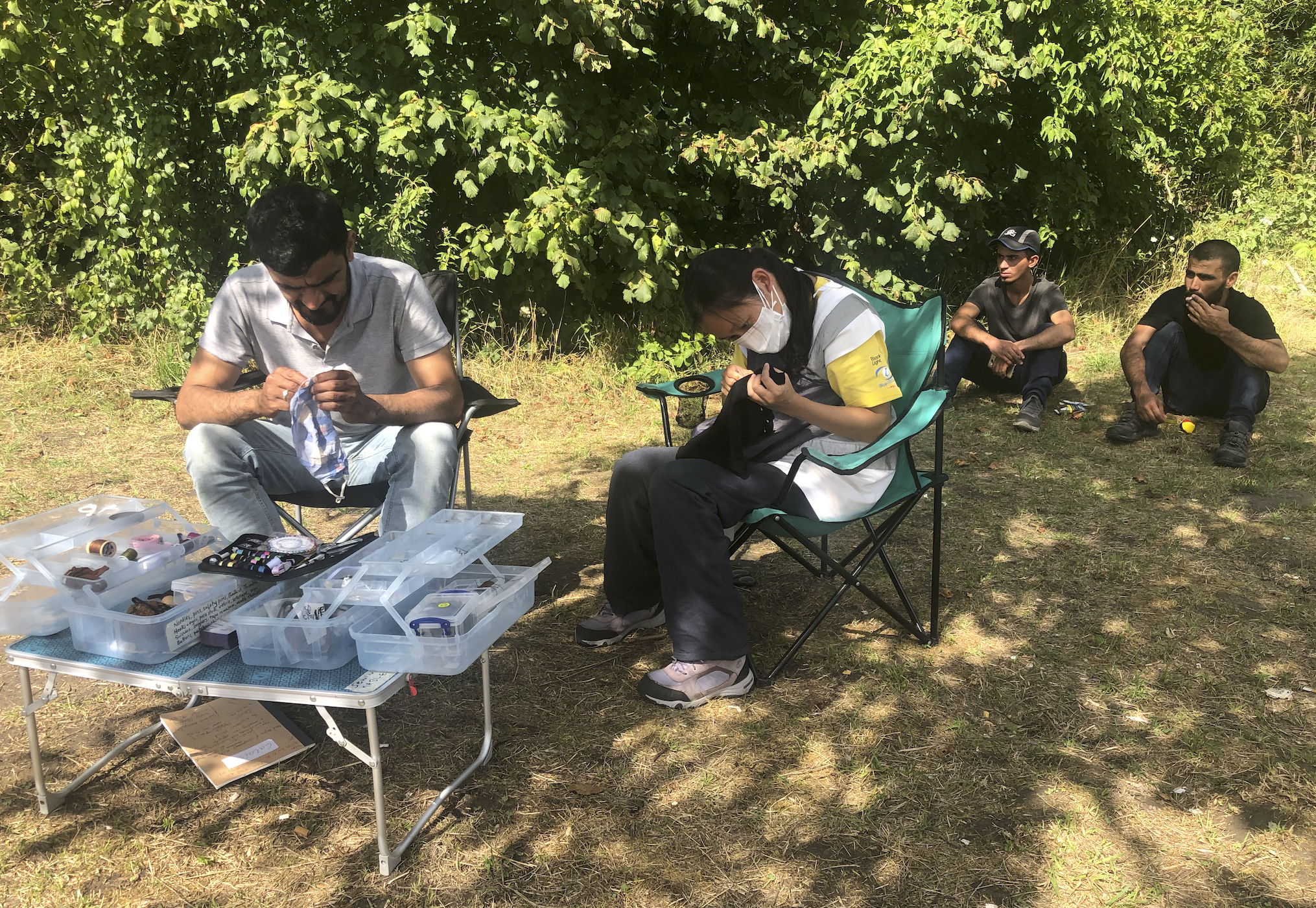
Sewing in the sun at Dunkerque on our last day
We chatted to the owner of the new hat, and the conversation turned to where I was from, to which I replied Derby. After a few mispronunciations, he said “Ah, Durby County!” I knew we’d connected, thanks to the global lingua franca that is football. He asked if matches had resumed post-pandemic, and I was able to explain that they had, but with recorded audience sounds instead of a live crowd (I do listen with half an ear when my husband talks about football).
An hour later, our patches were dry and Rebecca had done a great job on the hat. I showed her the unravel-proof finishing stitch my mum taught me, and we gave it to our gentleman, who was very pleased and elbow bumped each of us. Rebecca chatted to a Kurdish chap with a beard while he carried out his own sartorial repair.
We left early so we could attend the 6:30 vigil of the young man who had drowned. There was a silence, and some speakers including an asylum seeker from the Sudanese community. About 200 people were there, in a large circle in Place d’Armes. It was nice to see some Calais residents attending, as well as volunteers from the NGOs. Across the road, we could hear the French police chatting and laughing throughout, as well as videoing, which we’d been asked not to do.
Final thoughts
I really enjoyed my first stint of volunteering overseas. Parts of the experience were heartbreaking, but at other times our afternoon distributions felt like a holiday, meeting friends from around the world, watching them play football and smelling food cooking on the barbeque. But even in August, the weather was getting cold, and conditions must have been miserable sleeping rough with very little equipment. I hope to go back to Calais in January, so if you have any old camping gear or warm clothes, I’m happy to collect them. Or you can give financially here. Thank you!
Two of the asylum seekers I met in Calais made it to the UK while I was still in quarantine. I visited each of them in September. The Home Office has placed them in hotels, and they are trying as best they can to access English classes and stay motivated in these difficult times. I hope they both get leave to remain here.

































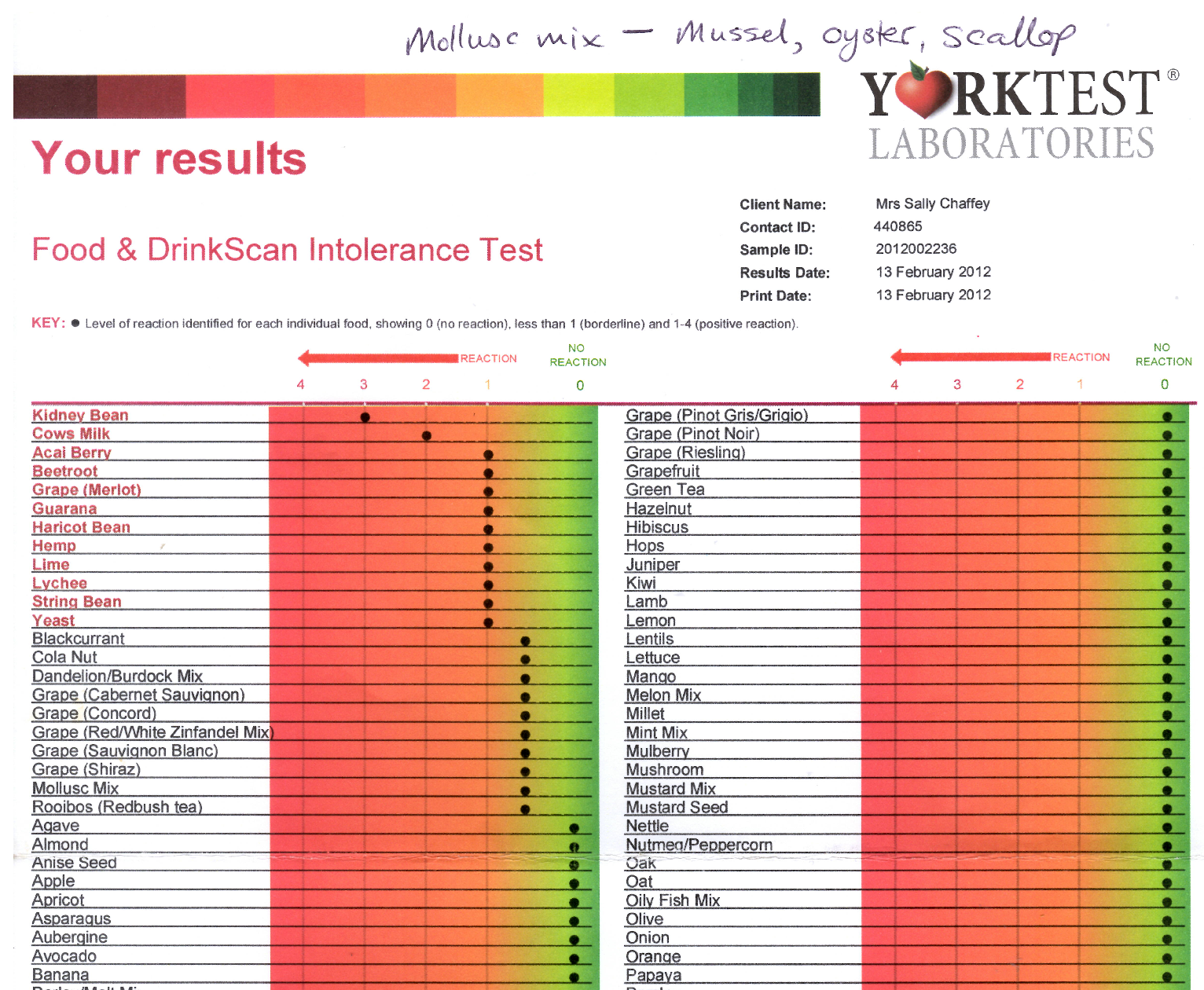
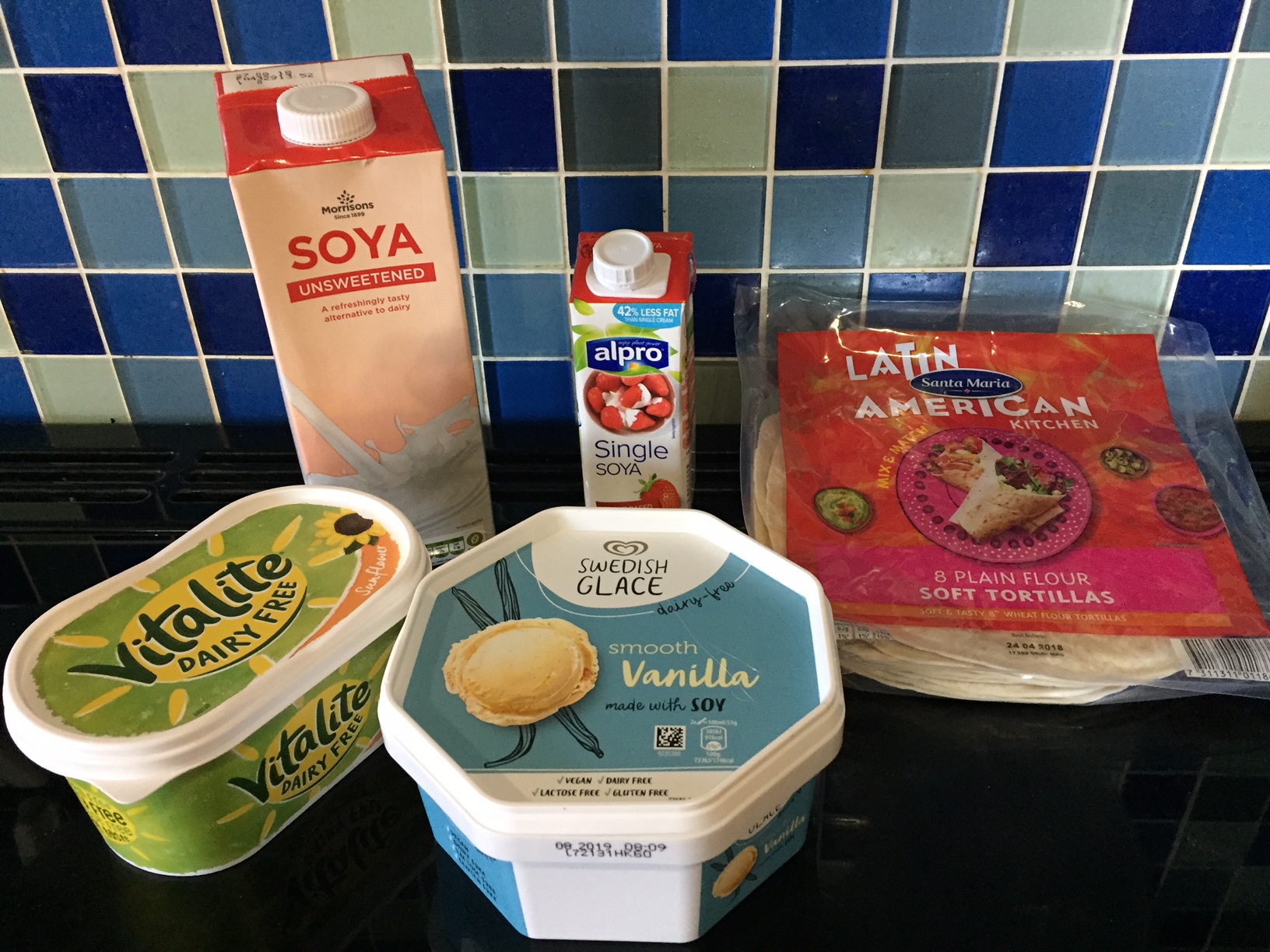
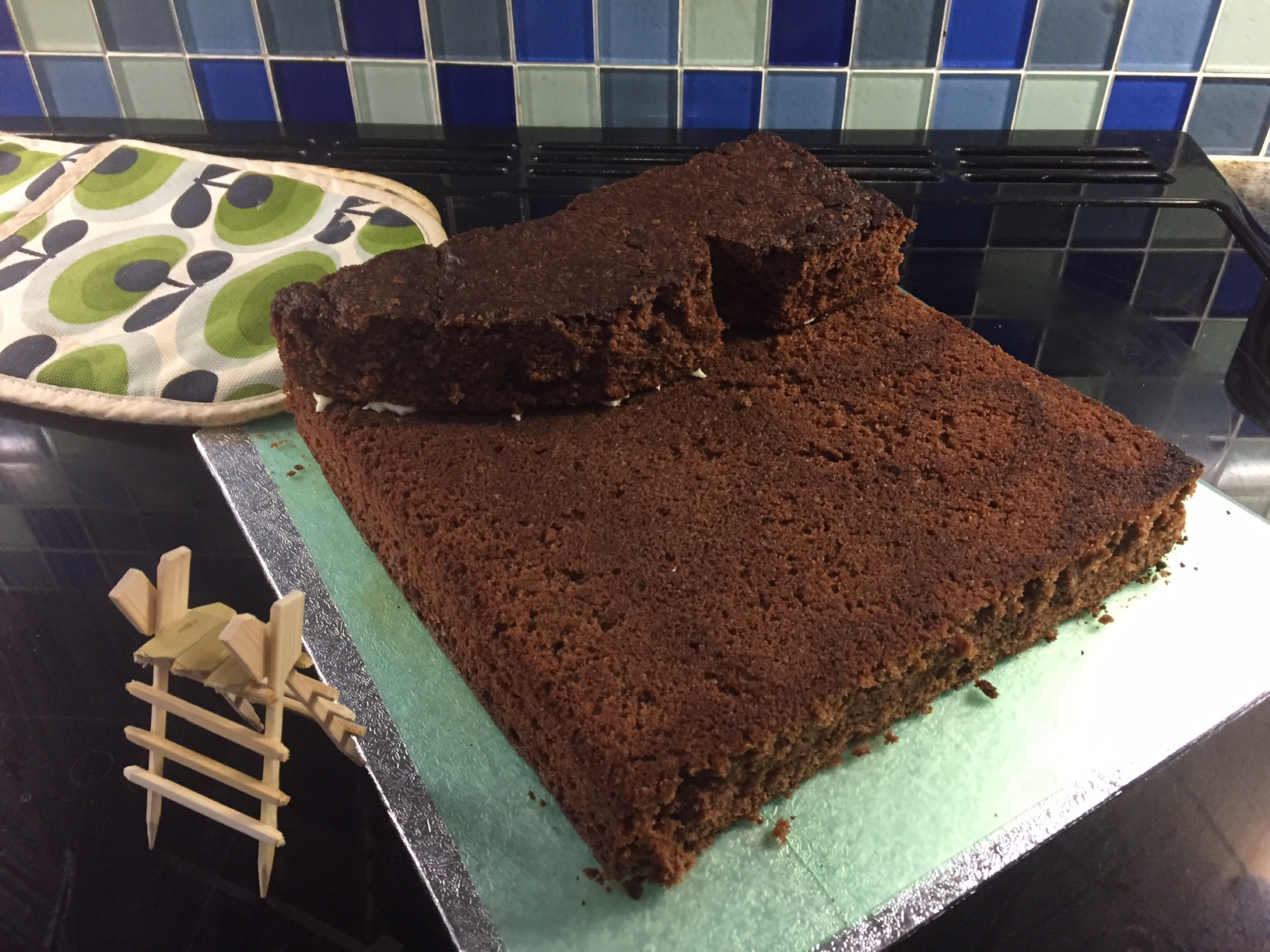 I did double quantity of my
I did double quantity of my 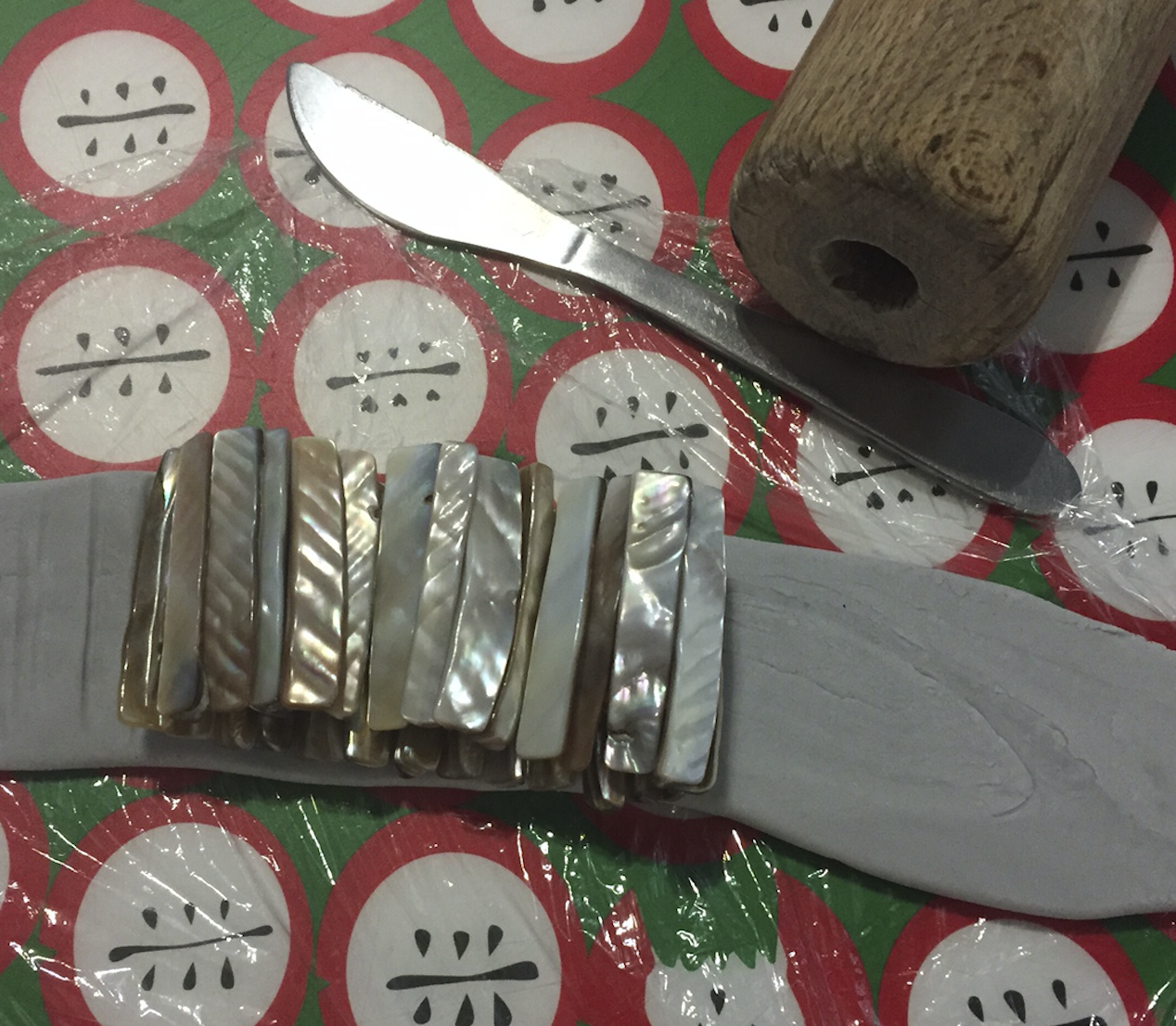 I made the limestone blocks in mainly rectangular shapes, but started with a triangle formation, so that there was some randomness. I put a thin layer of butter icing to hold them in place, then piped the green into the gaps afterwards. You could put the rocks directly onto the green icing, but you would need to have made them all first, otherwise the icing would dry.
I made the limestone blocks in mainly rectangular shapes, but started with a triangle formation, so that there was some randomness. I put a thin layer of butter icing to hold them in place, then piped the green into the gaps afterwards. You could put the rocks directly onto the green icing, but you would need to have made them all first, otherwise the icing would dry.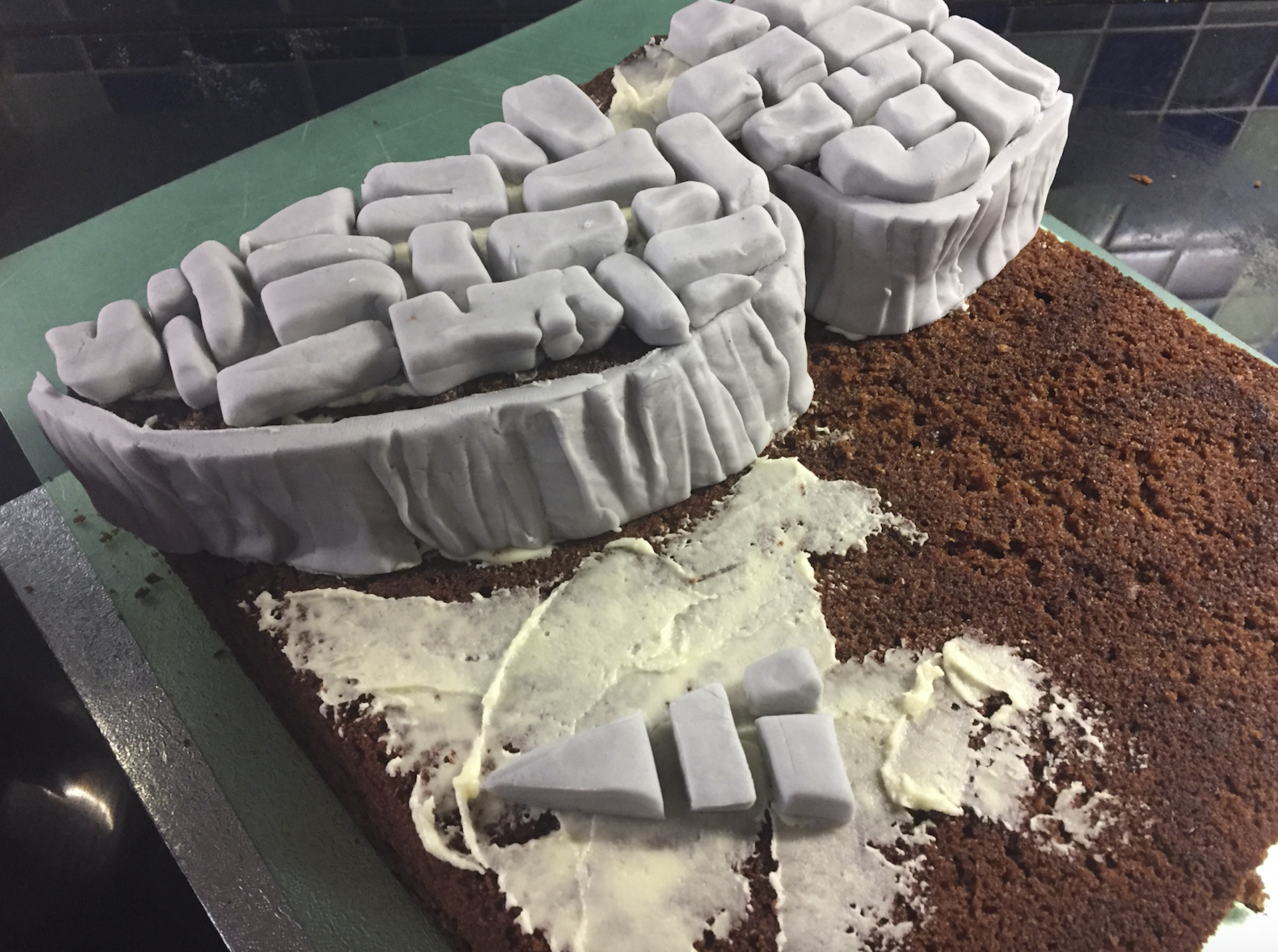
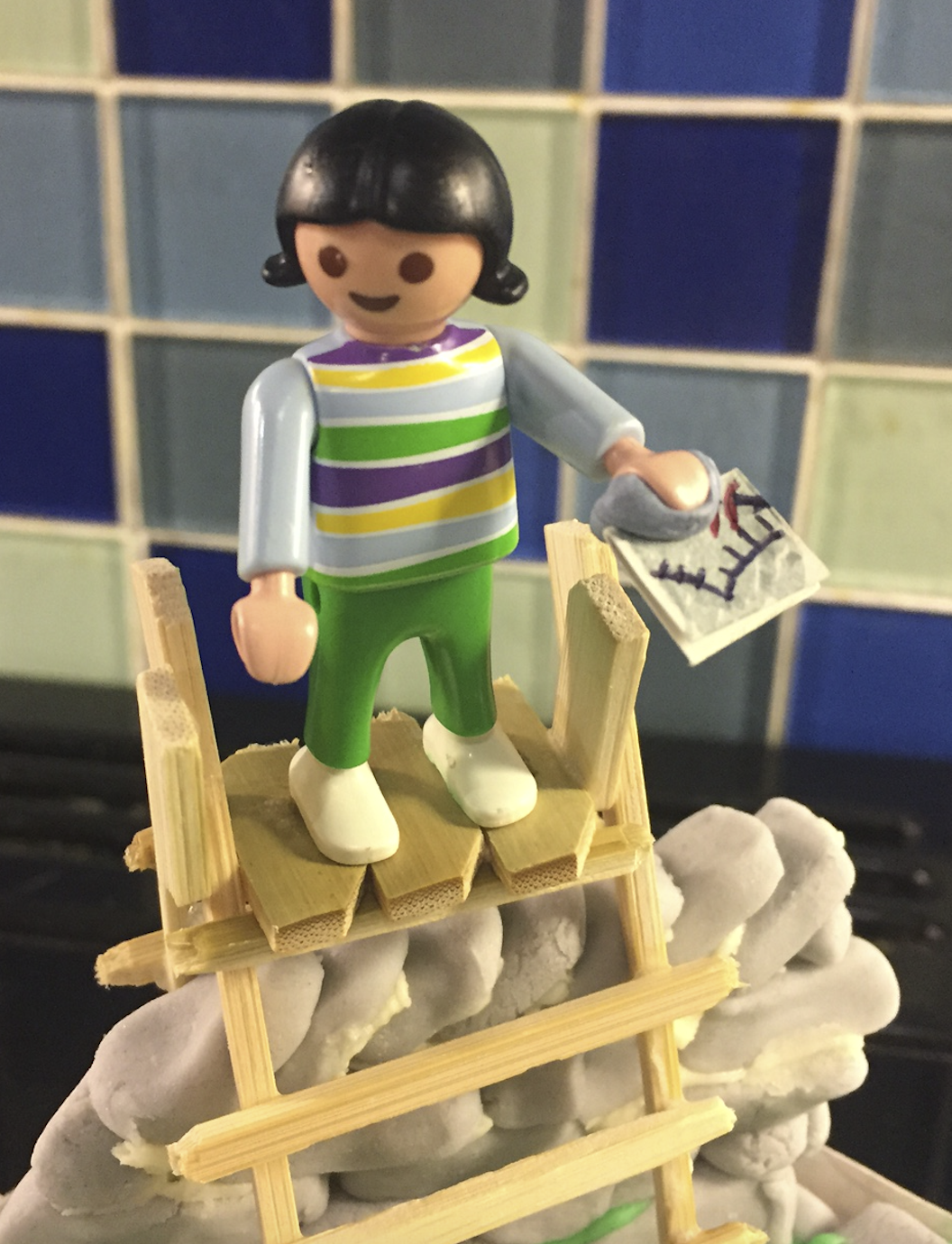 The wall was held together with butter icing, and finished with an authentic layer of coping stones. I butchered some old maps to cover up the edges and found a Playmobil man that looked a bit like Dave and even made him a tiny map!
The wall was held together with butter icing, and finished with an authentic layer of coping stones. I butchered some old maps to cover up the edges and found a Playmobil man that looked a bit like Dave and even made him a tiny map!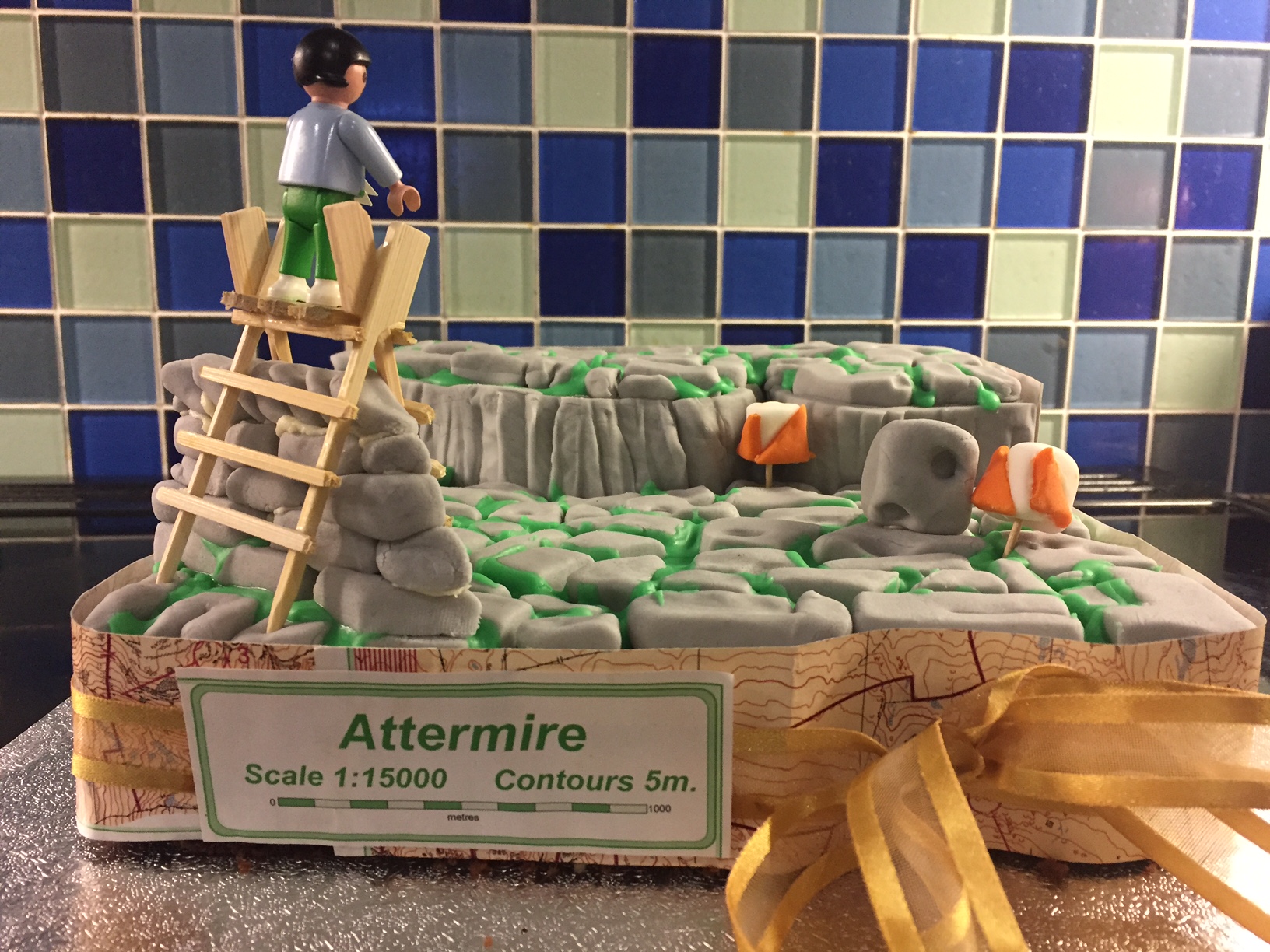
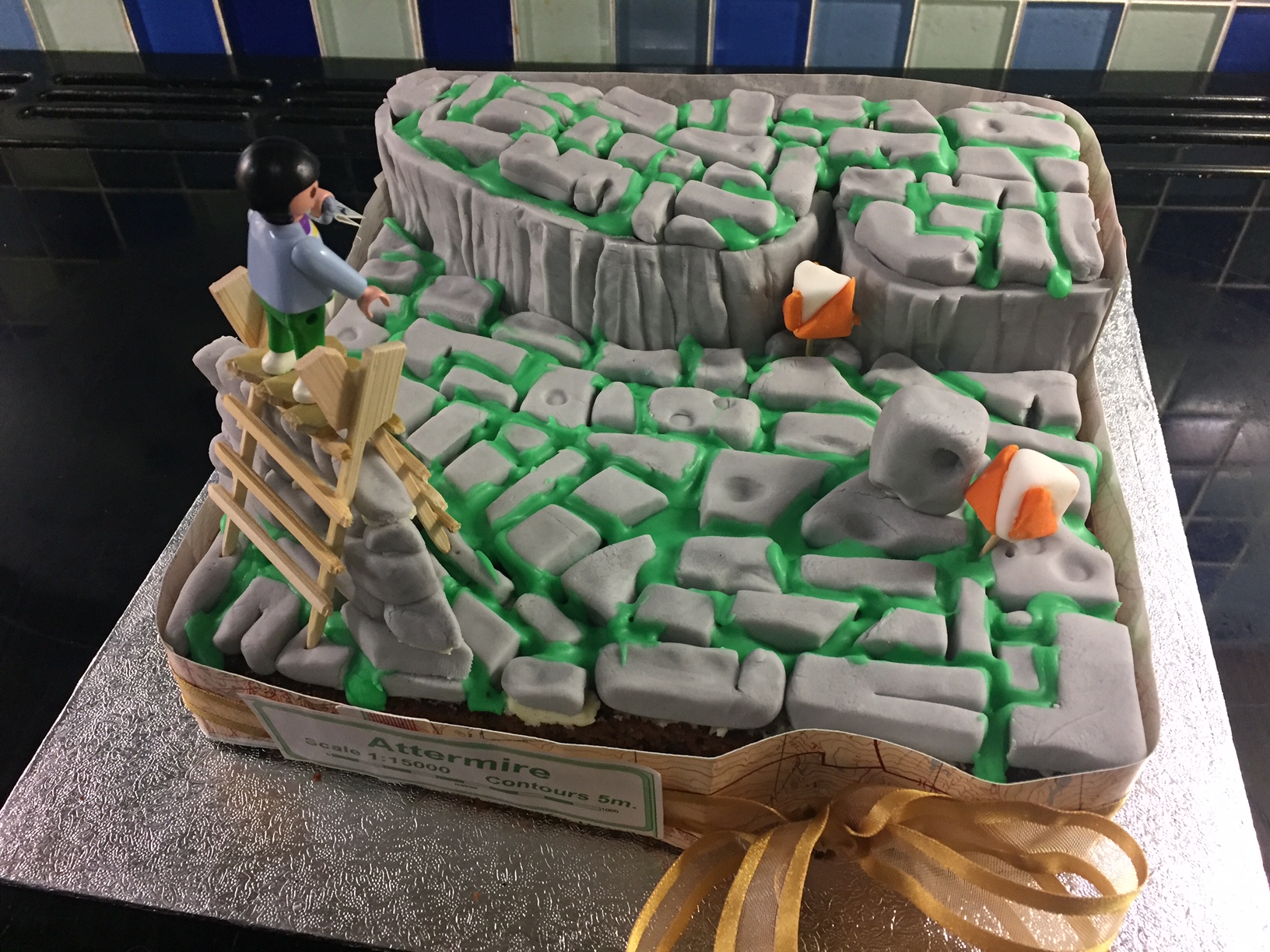
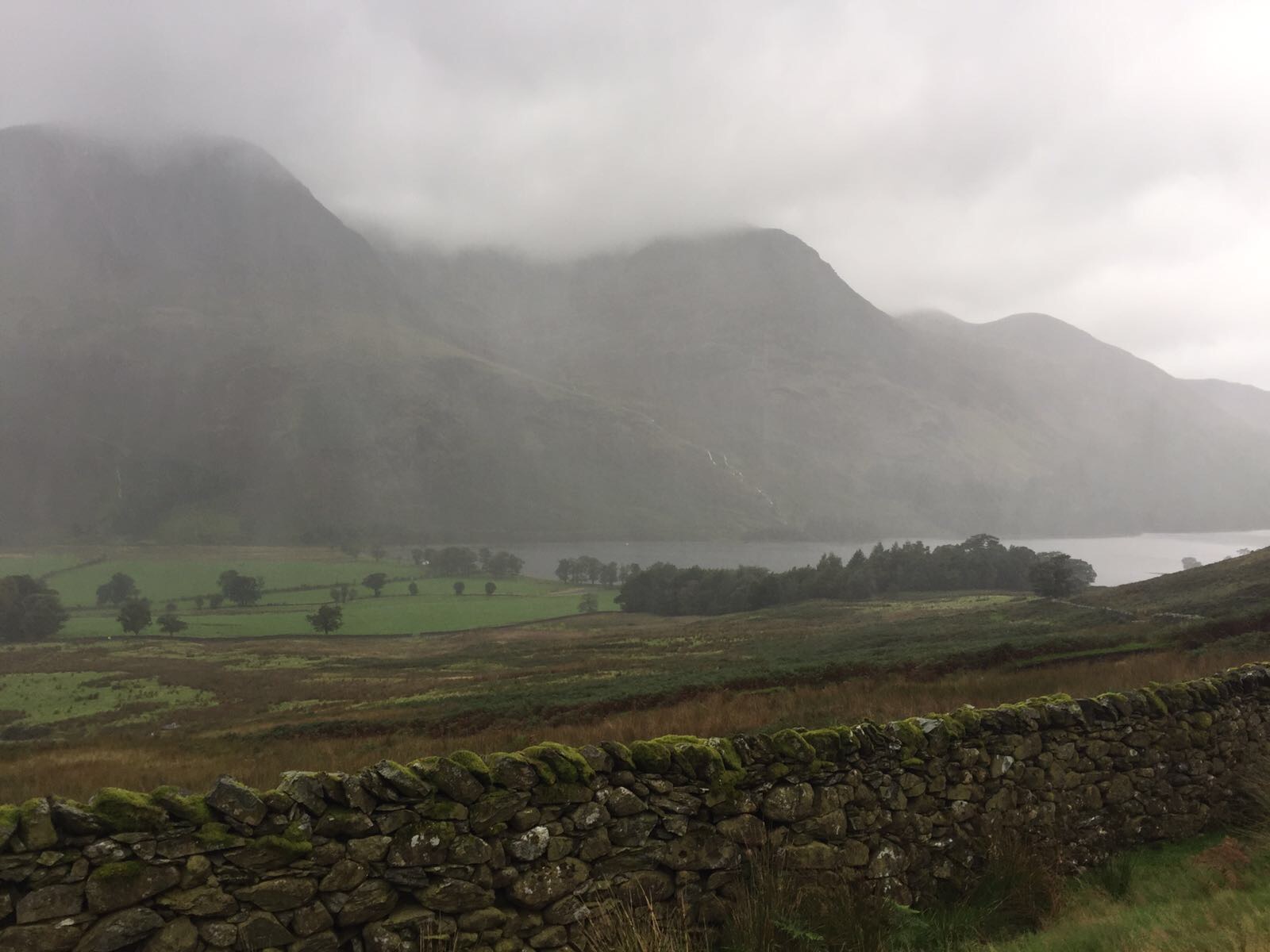

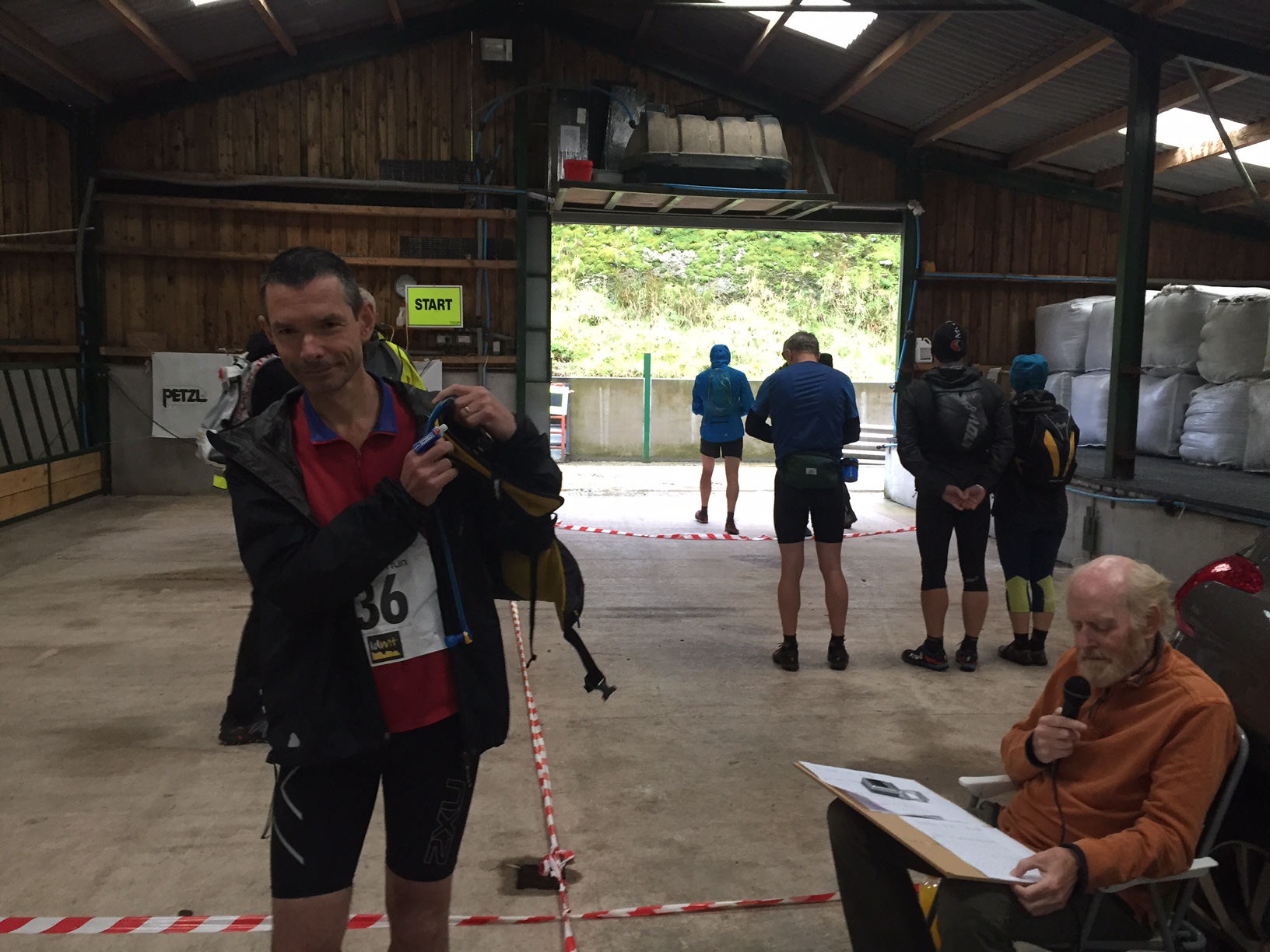
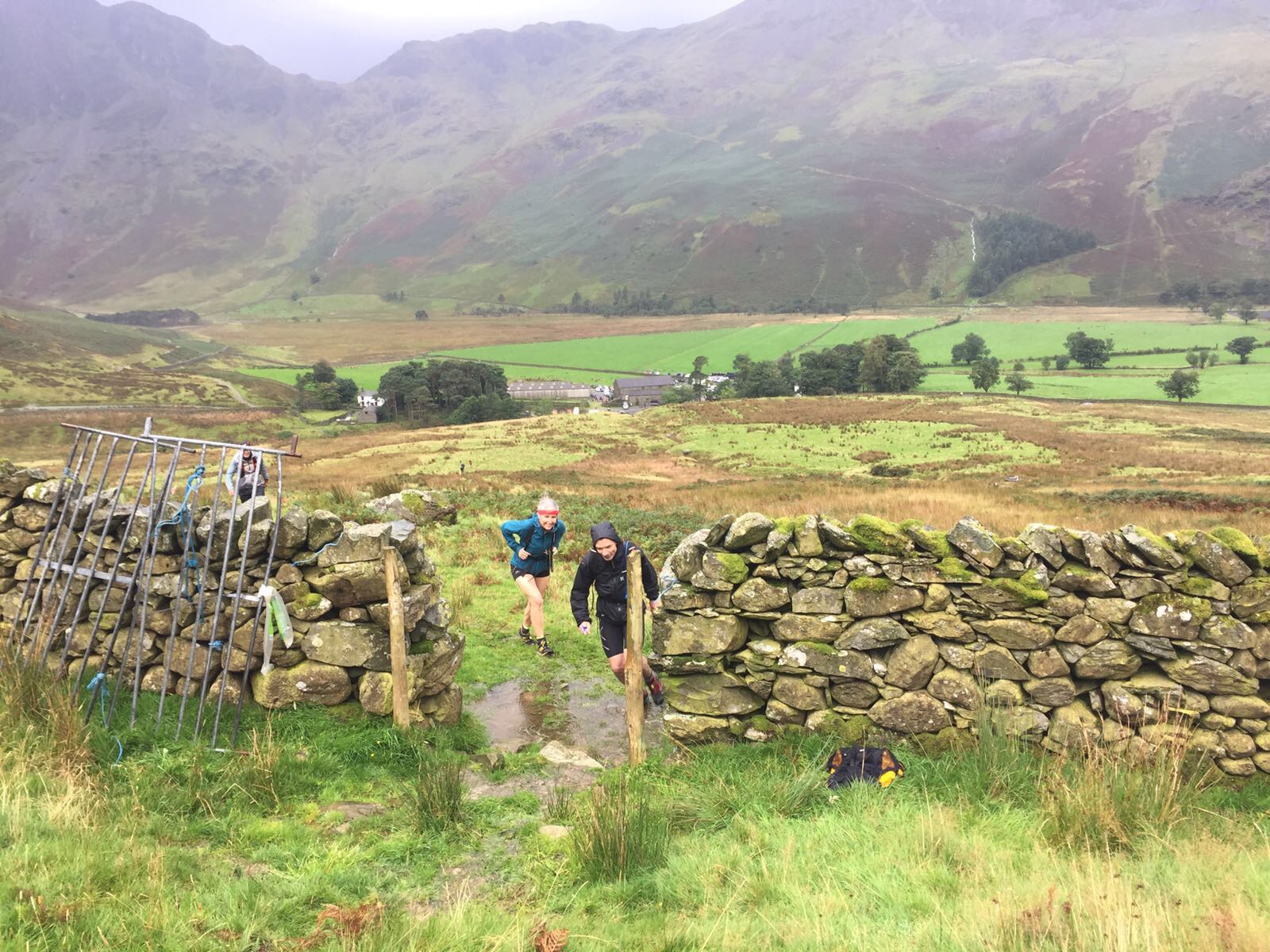
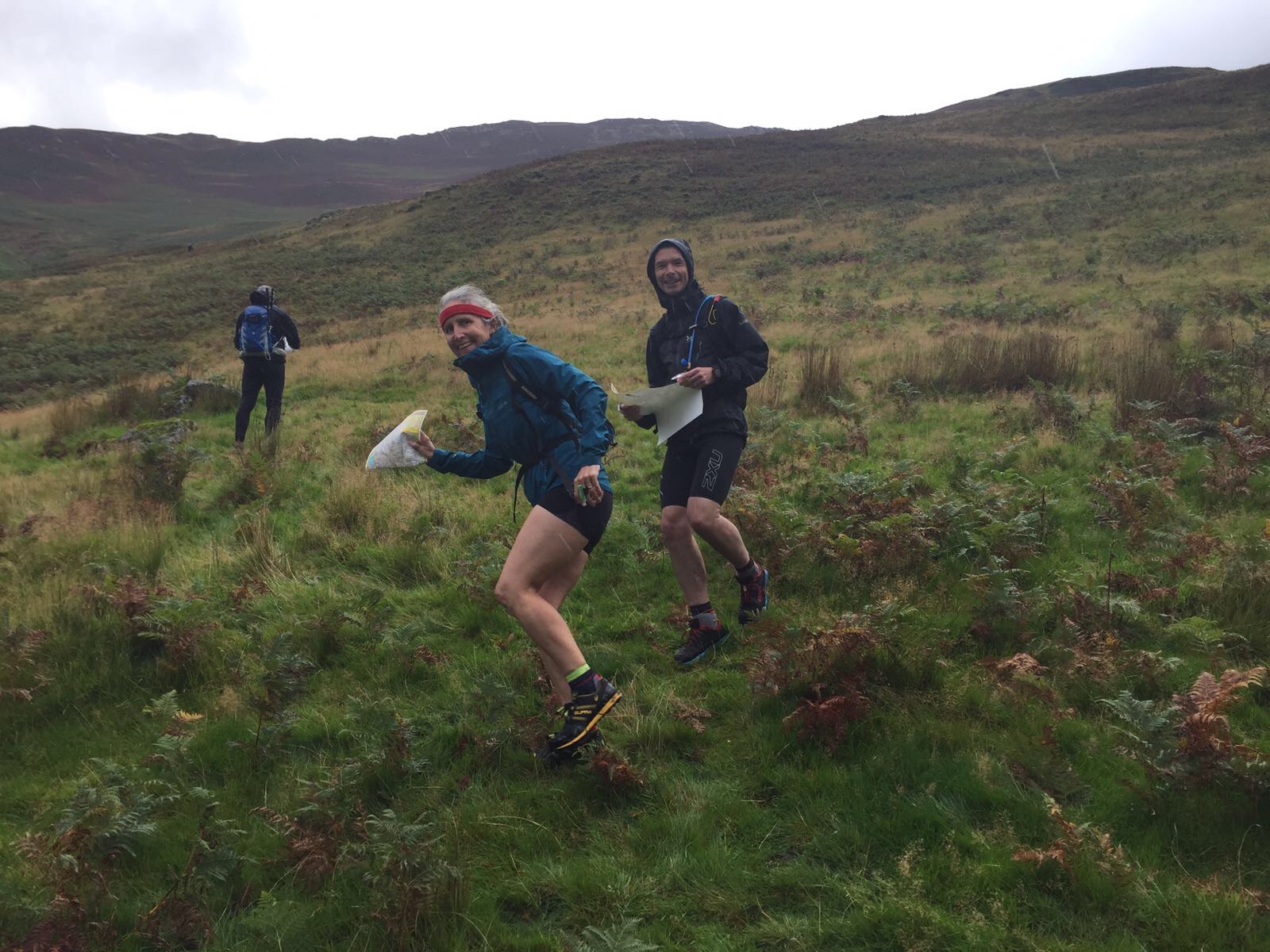

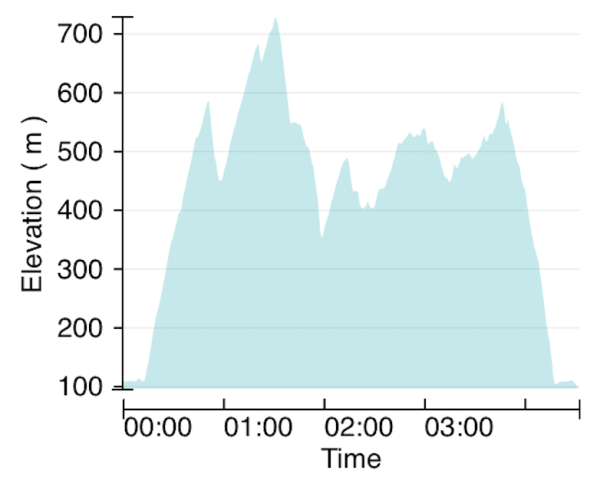 Our strategy to No 5 (south end of Blackbeck Tarn) was to contour then climb, as the GPS trace above doesn’t show the crags that were on our race map. We took a bit of a duff –but safe – route choice to No 6 via the tourist path over Haystacks, which was quite rocky, so we lost a bit of time here, as some rivals got to Scarth Gap before us. Then it was a quick descent back to Gatesgarth Farm, finishing in 4 hrs and 8 mins. Actual distance was 19.4 km (compared with 14.5 straight line) and 1347m climb (exactly as advertised). Altitude profile above, showing the dip at 2 hrs when we crossed the road at the top of Honister Pass.
Our strategy to No 5 (south end of Blackbeck Tarn) was to contour then climb, as the GPS trace above doesn’t show the crags that were on our race map. We took a bit of a duff –but safe – route choice to No 6 via the tourist path over Haystacks, which was quite rocky, so we lost a bit of time here, as some rivals got to Scarth Gap before us. Then it was a quick descent back to Gatesgarth Farm, finishing in 4 hrs and 8 mins. Actual distance was 19.4 km (compared with 14.5 straight line) and 1347m climb (exactly as advertised). Altitude profile above, showing the dip at 2 hrs when we crossed the road at the top of Honister Pass.